MediaTek RT3290 802.11 b/g/n 1T1R WLAN MINI CARD User Manual Host
MediaTek Inc. 802.11 b/g/n 1T1R WLAN MINI CARD Host
MediaTek >
Contents
Host User Manual
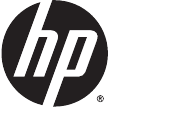
User Guide

© Copyright 2014 Hewlett-Packard
Development Company, L.P.
Bluetooth is a trademark owned by its
proprietor and used by Hewlett-Packard
Company under license. Intel is a
trademark of Intel Corporation in the U.S.
and other countries. Microsoft and Windows
are U.S. registered trademarks of the
Microsoft group of companies.
The information contained herein is subject
to change without notice. The only
warranties for HP products and services are
set forth in the express warranty statements
accompanying such products and services.
Nothing herein should be construed as
constituting an additional warranty. HP shall
not be liable for technical or editorial errors
or omissions contained herein.
First Edition: February 2014
Document Part Number: 753647-001
© Copyright 2014 Hewlett-Packard
Development Company, L.P.
Product notice
This guide describes features that are
common to most models. Some features
may not be available on your computer.
Not all features are available in all editions
of Windows. This computer may require
upgraded and/or separately purchased
hardware, drivers and/or software to take
full advantage of Windows functionality. Go
to http://www.microsoft.com for details.
To obtain the latest information in this
guide, contact support. For U.S. support, go
to http://www.hp.com/go/contactHP. For
worldwide support, go to
http://welcome.hp.com/country/us/en/
wwcontact_us.html.
Software terms
By installing, copying, downloading, or
otherwise using any software product
preinstalled on this computer, you agree to
be bound by the terms of the HP End User
License Agreement (EULA). If you do not
accept these license terms, your sole
remedy is to return the entire unused
product (hardware and software) within 14
days for a full refund subject to the refund
policy of your seller.
For any further information or to request a
full refund of the price of the computer,
please contact your seller.

Safety warning notice
WARNING! To reduce the possibility of heat-related injuries or of overheating the computer, do not
place the computer directly on your lap or obstruct the computer air vents. Use the computer only on
a hard, flat surface. Do not allow another hard surface, such as an adjoining optional printer, or a soft
surface, such as pillows or rugs or clothing, to block airflow. Also, do not allow the AC adapter to
come into contact with the skin or a soft surface, such as pillows or rugs or clothing, during operation.
The computer and the AC adapter comply with the user-accessible surface temperature limits defined
by the International Standard for Safety of Information Technology Equipment (IEC 60950).
iii
iv Safety warning notice

Table of contents
1 Starting right ...................................................................................................................................................... 1
Visit the HP Apps Store ........................................................................................................................ 1
Best practices ....................................................................................................................................... 1
Fun things to do .................................................................................................................................... 1
More HP resources .............................................................................................................................. 3
2 Getting to know your computer ......................................................................................................................... 5
Finding your hardware and software information ................................................................................. 5
Locating hardware ............................................................................................................... 5
Locating software ................................................................................................................. 5
Right side ............................................................................................................................................. 6
Left side ................................................................................................................................................ 7
Display .................................................................................................................................................. 9
Changing your notebook to an entertainment stand .......................................................... 10
Changing your notebook to a tablet ................................................................................... 10
Top ..................................................................................................................................................... 11
TouchPad .......................................................................................................................... 11
Lights ................................................................................................................................. 12
Speakers ............................................................................................................................ 12
Keys ................................................................................................................................... 13
Labels ................................................................................................................................................. 13
3 Connecting to a network ................................................................................................................................. 15
Connecting to a wireless network ....................................................................................................... 15
Using the wireless controls ................................................................................................ 15
Using the wireless button .................................................................................. 15
Using operating system controls ....................................................................... 16
Sharing data and drives and accessing software .............................................................. 16
Using a WLAN ................................................................................................................... 16
Using an Internet service provider .................................................................... 17
Setting up a WLAN ............................................................................................ 17
Configuring a wireless router ............................................................................ 17
Protecting your WLAN ....................................................................................... 17
Connecting to a WLAN ...................................................................................... 18
Using HP Mobile Broadband (select models only) ............................................................ 18
Inserting and removing a SIM (select models only) .......................................... 19
v
Using Bluetooth wireless devices (select models only) ..................................................... 20
Connecting to a wired network ........................................................................................................... 20
Connecting to a local area network (LAN) ......................................................................... 20
4 Enjoying entertainment features ..................................................................................................................... 21
Multimedia features ............................................................................................................................ 21
Using the webcam .............................................................................................................................. 22
Using audio ........................................................................................................................................ 23
Connecting speakers ......................................................................................................... 23
Connecting headphones and microphones ....................................................................... 23
Using Beats Audio ............................................................................................................. 23
Accessing Beats Audio Control Panel ............................................................... 23
Enabling and disabling Beats Audio .................................................................. 23
Testing your audio features ............................................................................................... 23
Using video ......................................................................................................................................... 24
Connecting video devices by using an HDMI cable ........................................................... 24
Setting up HDMI audio ...................................................................................... 25
Discovering and connecting to Miracast-compatible wireless displays ............................. 25
5 Navigating the screen ..................................................................................................................................... 26
Using the TouchPad and gestures ..................................................................................................... 26
Tapping .............................................................................................................................. 27
Scrolling ............................................................................................................................. 28
2-finger pinch zoom ........................................................................................................... 28
2-finger click ....................................................................................................................... 29
Edge swipes ...................................................................................................................... 29
Right-edge swipe .............................................................................................. 29
Left-edge swipe ................................................................................................. 30
Top-edge swipe ................................................................................................. 30
Using touch screen gestures .............................................................................................................. 31
One-finger slide ................................................................................................................. 31
Tapping .............................................................................................................................. 32
Scrolling ............................................................................................................................. 32
2-finger pinch zoom ........................................................................................................... 33
Edge swipes ...................................................................................................................... 34
Right-edge swipe .............................................................................................. 34
Left-edge swipe ................................................................................................. 34
Top-edge swipe and bottom-edge swipe .......................................................... 35
Using the keyboard and mouse .......................................................................................................... 35
Using the keys ................................................................................................................... 35
Using the action keys ........................................................................................ 35
vi
Using Windows shortcut keys ........................................................................... 36
Using the hot keys ............................................................................................. 37
6 Managing power ............................................................................................................................................. 38
Initiating Sleep and Hibernation ......................................................................................................... 38
Manually initiating and exiting Sleep .................................................................................. 39
Manually initiating and exiting Hibernation (select models only) ....................................... 39
Setting password protection on wakeup ............................................................................ 39
Using the power meter and power settings ........................................................................................ 40
Running on battery power .................................................................................................................. 40
Factory-sealed battery ....................................................................................................... 40
Finding battery information ................................................................................................ 40
Conserving battery power .................................................................................................. 40
Identifying low battery levels .............................................................................................. 41
Resolving a low battery level ............................................................................................. 41
Resolving a low battery level when external power is available ........................ 41
Resolving a low battery level when no power source is available ..................... 41
Resolving a low battery level when the computer cannot exit Hibernation ....... 41
Running on external AC power .......................................................................................................... 41
Troubleshooting power problems ...................................................................................... 42
HP CoolSense .................................................................................................................................... 43
Refreshing your software content with Intel Smart Connect Technology (select models only) .......... 43
Shutting down (turning off) the computer ........................................................................................... 43
7 Maintaining your computer .............................................................................................................................. 45
Improving performance ...................................................................................................................... 45
Using HP 3D DriveGuard ................................................................................................... 45
Identifying HP 3D DriveGuard status ................................................................ 45
Using Disk Defragmenter ................................................................................................... 45
Using Disk Cleanup ........................................................................................................... 46
Updating programs and drivers .......................................................................................................... 46
Cleaning your computer ..................................................................................................................... 46
Cleaning procedures .......................................................................................................... 47
Cleaning the display (All-in-Ones or Notebooks) .............................................. 47
Cleaning the sides or cover ............................................................................... 47
Cleaning the TouchPad, keyboard, or mouse ................................................... 47
Traveling with or shipping your computer ........................................................................................... 47
8 Securing your computer and information ........................................................................................................ 49
Using passwords ................................................................................................................................ 49
vii
Setting Windows passwords .............................................................................................. 50
Setting Setup Utility (BIOS) passwords ............................................................................. 50
Using Internet security software ......................................................................................................... 50
Using antivirus software ..................................................................................................... 51
Using firewall software ....................................................................................................... 51
Installing software updates ................................................................................................................. 51
Installing critical security updates ...................................................................................... 51
Installing HP and third-party software updates .................................................................. 51
Securing your wireless network .......................................................................................................... 52
Backing up your software applications and information ..................................................................... 52
Using an optional security cable lock ................................................................................................. 52
9 Using Setup Utility (BIOS) and HP PC Hardware Diagnostics (UEFI) ............................................................ 53
Starting Setup Utility (BIOS) ............................................................................................................... 53
Updating the BIOS ............................................................................................................................. 53
Determining the BIOS version ........................................................................................... 53
Downloading a BIOS update ............................................................................................. 54
Using HP PC Hardware Diagnostics (UEFI) ...................................................................................... 54
Downloading HP PC Hardware Diagnostics (UEFI) to a USB device ............................... 55
10 Backing up, restoring, and recovering .......................................................................................................... 56
Creating recovery media and backups ............................................................................................... 56
Creating HP Recovery media ............................................................................................ 56
Restore and recovery ......................................................................................................................... 57
Recovering using HP Recovery Manager .......................................................................... 58
What you need to know ..................................................................................... 58
Using the HP Recovery partition (select models only) ...................................... 58
Using HP Recovery media to recover ............................................................... 59
Changing the computer boot order ................................................................... 59
Removing the HP Recovery partition ................................................................................. 59
11 Specifications ................................................................................................................................................ 60
Input power ......................................................................................................................................... 60
Operating environment ....................................................................................................................... 60
12 Electrostatic Discharge ................................................................................................................................. 61
Index ................................................................................................................................................................... 62
viii

1 Starting right
This computer is a powerful tool designed to enhance your work and entertainment. Read this
chapter to learn about best practices after you set up your computer, fun things to do with your
computer, and where to find additional HP resources.
Visit the HP Apps Store
The HP Apps Store offers a wide choice of popular games, entertainment and music apps,
productivity apps, and apps exclusive to HP that you can download to the Start screen. The selection
is updated regularly and includes regional content and country-specific offers. Be sure to check the
HP Apps Store frequently for new and updated features.
IMPORTANT: You must be connected to the Internet to access the HP Apps Store.
To view and download an app:
1. From the Start screen, select the Store app.
2. Select HP Picks to view all the available apps.
3. Select the app you want to download, and then follow the on-screen instructions. When the
download is complete, the app appears on the All apps screen.
Best practices
To get the most out of your smart investment, after you set up and register the computer, we
recommend the following steps:
●If you haven’t already done so, connect to a wired or wireless network. See details in Connecting
to a network on page 15.
●Take a minute to browse the printed
Windows Basics
guide to explore the new Windows®
features.
●Become familiar with the computer hardware and software. For more information, see Getting to
know your computer on page 5 and Enjoying entertainment features on page 21.
●Update or purchase antivirus software. See Using antivirus software on page 51.
●Back up your hard drive by creating recovery discs or a recovery flash drive. See Backing up,
restoring, and recovering on page 56.
Fun things to do
●You know that you can watch a YouTube video on the computer. But did you know that you can
also connect your computer to a TV or gaming console? For more information, see Connecting
video devices by using an HDMI cable on page 24.
●You know that you can listen to music on the computer. But did you know that you can also
stream live radio to the computer and listen to music or talk radio from all over the world? See
Using audio on page 23.
Visit the HP Apps Store 1

●You know that you can create a powerful presentation with Microsoft® applications. But did you
know you can also connect to a projector to share your ideas with a group? See Connecting
video devices by using an HDMI cable on page 24.
●Experience music the way the artist intended, with deep controlled bass and clear, pure sound.
See Using Beats Audio on page 23.
●Use the TouchPad and the new Windows touch gestures for smooth control of images and
pages of text. See Using the TouchPad and gestures on page 26.
2 Chapter 1 Starting right

More HP resources
You have already used
Setup Instructions
to turn on the computer and locate this guide. To locate
resources that provide product details, how-to information, and more, use this table.
Resource Contents
Setup Instructions
●Overview of computer setup and features
Windows Basics
guide ●Overview of using Windows
Help and Support
To access Help and Support, from the Start screen,
type help, and then from the Search window, select
Help and Support. For U.S. support, go to
http://www.hp.com/go/contactHP. For worldwide
support, go to http://welcome.hp.com/country/us/en/
wwcontact_us.html.
●A broad range of how-to information and troubleshooting tips
Worldwide support
To get support in your language, go to
http://welcome.hp.com/country/us/en/
wwcontact_us.html.
●Online chat with an HP technician
●Email support
●Support telephone numbers
●HP service center locations
Safety & Comfort Guide
To access this guide:
1. From the Start screen, type support, and then
select the HP Support Assistant app.
2. Select My computer, and then select User
guides.
or
Go to http://www.hp.com/ergo.
●Proper workstation setup
●Guidelines for posture and work habits that increase your
comfort and decrease your risk of injury
●Electrical and mechanical safety information
Regulatory, Safety and Environmental Notices
To access this guide:
▲From the Start screen, type support, and then
select the HP Support Assistant app.
●Important regulatory notices, including proper battery disposal
information
Limited Warranty
*
To access this guide:
1. From the Start screen, type support, and then
select the HP Support Assistant app.
2. Select My computer, and then select Warranty
and services.
or
Go to http://www.hp.com/go/orderdocuments.
●Specific warranty information about this computer
*You can find the expressly provided HP Limited Warranty applicable to your product located with the user guides on your
computer and/or on the CD/DVD provided in the box. In some countries/regions, HP may provide a printed HP Limited
Warranty in the box. For countries/regions where the warranty is not provided in printed format, you may request a printed
copy from http://www.hp.com/go/orderdocuments or write to:
●North America: Hewlett-Packard, MS POD, 11311 Chinden Blvd., Boise, ID 83714, USA
More HP resources 3

Resource Contents
●Europe, Middle East, Africa: Hewlett-Packard, POD, Via G. Di Vittorio, 9, 20063, Cernusco s/Naviglio (MI), Italy
●Asia Pacific: Hewlett-Packard, POD, P.O. Box 200, Alexandra Post Office, Singapore 911507
When you request a printed copy of your warranty, please include your product number, warranty period (found on your
service label), name, and postal address.
IMPORTANT: Do NOT return your HP product to the addresses above. For U.S. support, go to http://www.hp.com/go/
contactHP. For worldwide support, go to http://welcome.hp.com/country/us/en/wwcontact_us.html.
4 Chapter 1 Starting right

2 Getting to know your computer
Finding your hardware and software information
Locating hardware
To find out what hardware is installed on your computer:
1. From the Start screen, type control panel, and then select Control Panel.
2. Select System and Security, select System, and then click Device Manager in the left column.
A list displays all the devices installed on your computer.
To find out information about system hardware components and the system BIOS version number,
press fn+esc.
Locating software
To find out what software is installed on your computer:
▲From the Start screen, click the down arrow in the lower-left corner of the screen.
Finding your hardware and software information 5
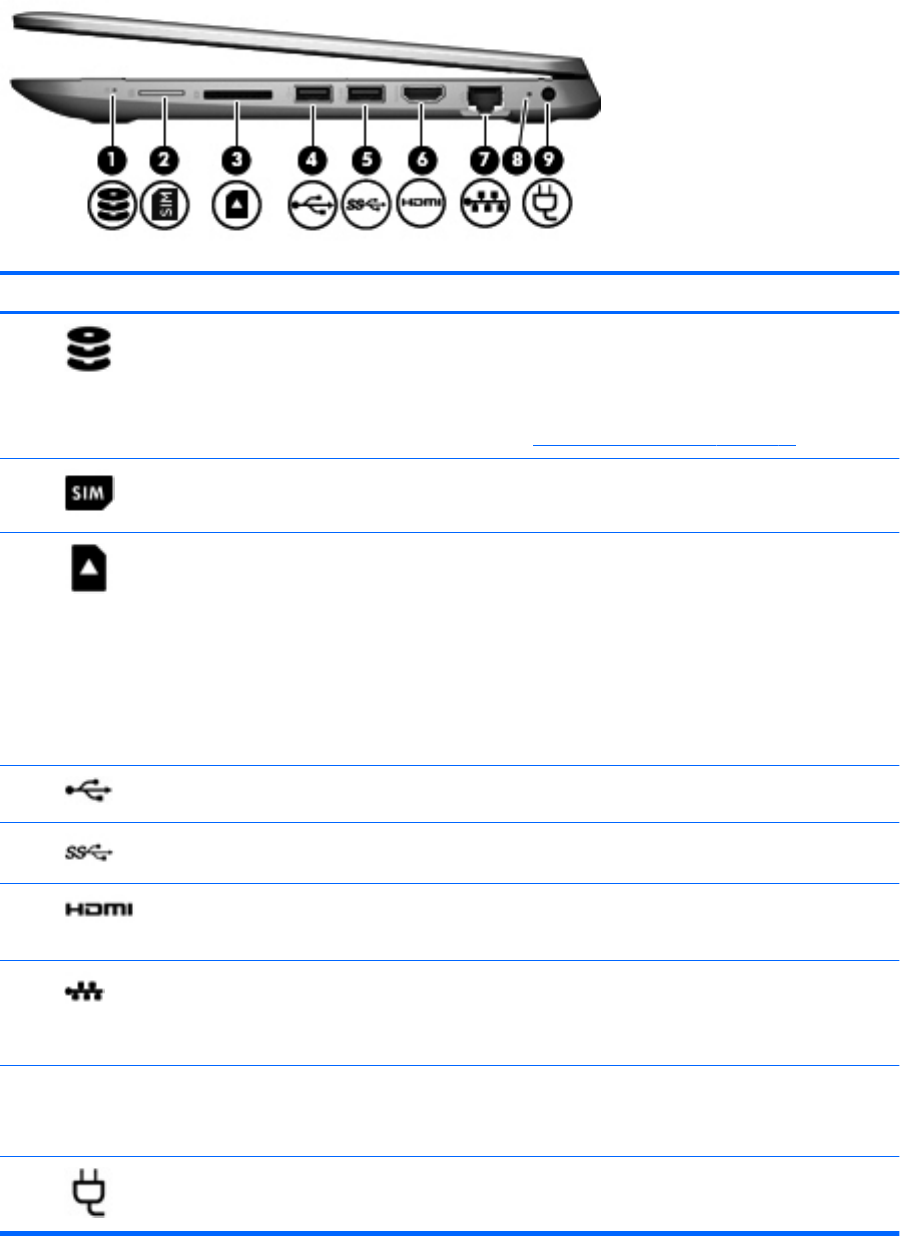
Right side
Component Description
(1) Hard drive light ●Blinking white: The hard drive is being accessed.
●Amber: HP 3D DriveGuard has temporarily parked the
hard drive.
NOTE: For information about HP 3D DriveGuard,
see Using HP 3D DriveGuard on page 45.
(2) SIM slot (select models only) Supports a wireless subscriber identity module (SIM).
(3) Memory card reader Reads optional memory cards that store, manage, share, or
access information.
To insert a card:
Hold the card label-side up, with connectors facing the slot,
insert the card into the slot, and then push in on the card
until it is firmly seated.
To remove a card:
Press in on the card it until it pops out.
(4) USB 2.0 port Connects an optional USB device, such as a keyboard,
mouse, external drive, printer, scanner or USB hub.
(5) USB 3.0 port Connects an optional USB device, such as a keyboard,
mouse, external drive, printer, scanner or USB hub.
(6) HDMI port Connects an optional video or audio device, such as a high-
definition television, any compatible digital or audio
component, or a high-speed HDMI device.
(7) RJ-45 (network) jack/status lights Connects a network cable.
●White: The network is connected.
●Amber: Activity is occurring on the network.
(8) AC adapter light ●On: The AC adapter is connected and the battery is
charged.
●Off: The computer is using battery power.
(9) Power connector Connects an AC adapter.
6 Chapter 2 Getting to know your computer
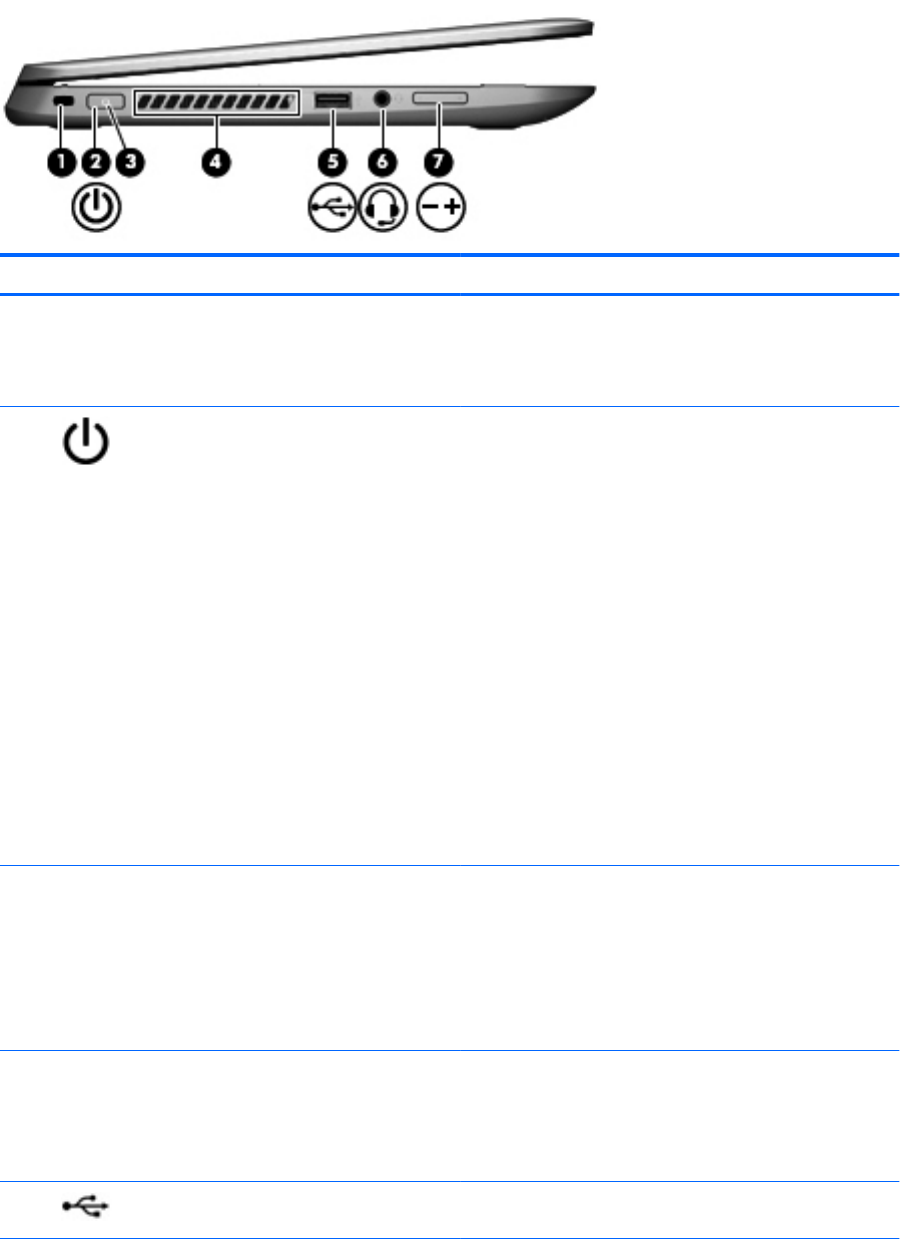
Left side
Component Description
(1) Security cable slot Attaches an optional security cable to the computer.
NOTE: The security cable is designed to act as a
deterrent, but it may not prevent the computer from being
mishandled or stolen.
(2) Power button ●When the computer is off, press the button to turn on
the computer.
●When the computer is on, press the button briefly to
initiate Sleep.
●When the computer is in the Sleep state, press the
button briefly to exit Sleep.
●When the computer is in Hibernation, press the button
briefly to exit Hibernation.
CAUTION: Pressing and holding down the power button
will result in the loss of unsaved information.
If the computer has stopped responding and Windows
shutdown procedures are ineffective, press and hold the
power button down for at least 5 seconds to turn off the
computer.
To learn more about your power settings, see your power
options. From the Start screen, type power, select Power
and sleep settings, and then select Power and sleep from
the list of applications.
(3) Power light ●On: The computer is on.
●Blinking: The computer is in the Sleep state, a power-
saving state. The computer shuts off power to the
display and other unneeded components.
●Off: The computer is off or in Hibernation. Hibernation
is a power-saving state that uses the least amount of
power.
(4) Vent Enables airflow to cool internal components.
NOTE: The computer fan starts up automatically to cool
internal components and prevent overheating. It is normal
for the internal fan to cycle on and off during routine
operation.
(5) USB 2.0 port Connects an optional USB device, such as a keyboard,
mouse, external drive, printer, scanner or USB hub.
Left side 7

Component Description
(6) Audio-out (headphone)/Audio-in
(microphone) jack
Connects optional powered stereo speakers, headphones,
earbuds, a headset, or a television audio cable. Also
connects an optional headset microphone. This jack does
not support optional microphone-only devices.
WARNING! To reduce the risk of personal injury, adjust
the volume before putting on headphones, earbuds, or a
headset. For additional safety information, refer to the
Regulatory, Safety, and Environmental Notices
. To access
this guide, from the Start screen, type support, and then
select the HP Support Assistant app.
NOTE: When a device is connected to the jack, the
computer speakers are disabled.
NOTE: Be sure that the device cable has a 4-conductor
connector that supports both audio-out (headphone) and
audio-in (microphone).
(7) Volume button Controls speaker volume.
To decrease speaker volume, press the edge of the
button.
To increase speaker volume, press the + edge of the
button.
8 Chapter 2 Getting to know your computer
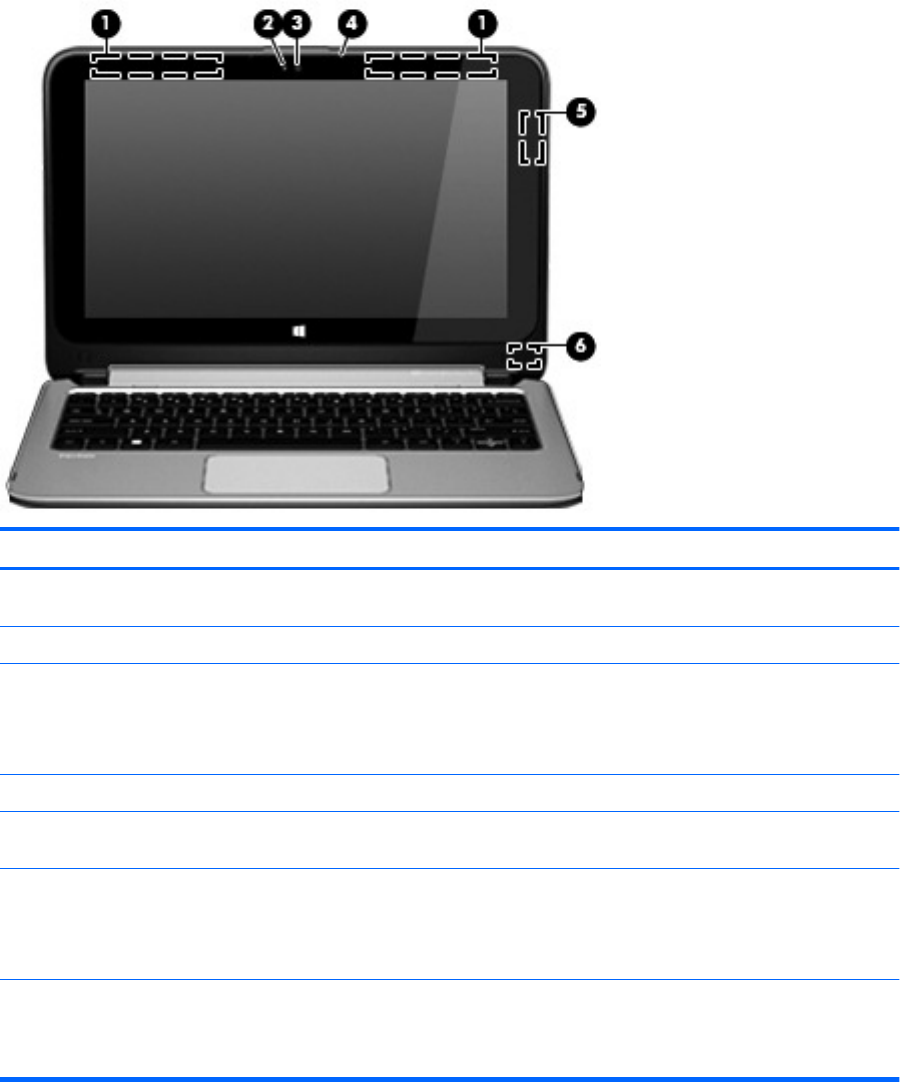
Display
Component Description
(1) WWAN antennas (2)* (select models only) Send and receive wireless signals to communicate with wireless
wide area networks (WWAN).
(2) Webcam light On: The webcam is in use.
(3) Webcam Records video and captures photographs. Some models allow
you to video conference and chat online using streaming video.
To use the webcam, from the Start screen, type camera, and
then select Camera from the list of applications.
(4) Internal microphone Records sound.
(5) WLAN antenna* Sends and receives wireless signals to communicate with
wireless local area networks (WLANs).
(6) Internal display switch Turns off the display and initiates Sleep if the display is closed
while the power is on.
NOTE: The internal display switch is not visible from the
outside of the computer.
*The antennas are not visible from the outside of the computer. For optimal transmission, keep the areas immediately
around the antennas free from obstructions. For wireless regulatory notices, see the section of the
Regulatory, Safety, and
Environmental Notices
that applies to your country or region. To access this guide, from the Start screen, type support,
and then select the HP Support Assistant app.
Your computer can function as a classic notebook, and in addition, the display can be rotated so that
the computer transforms into an entertainment stand or a tablet.
Display 9
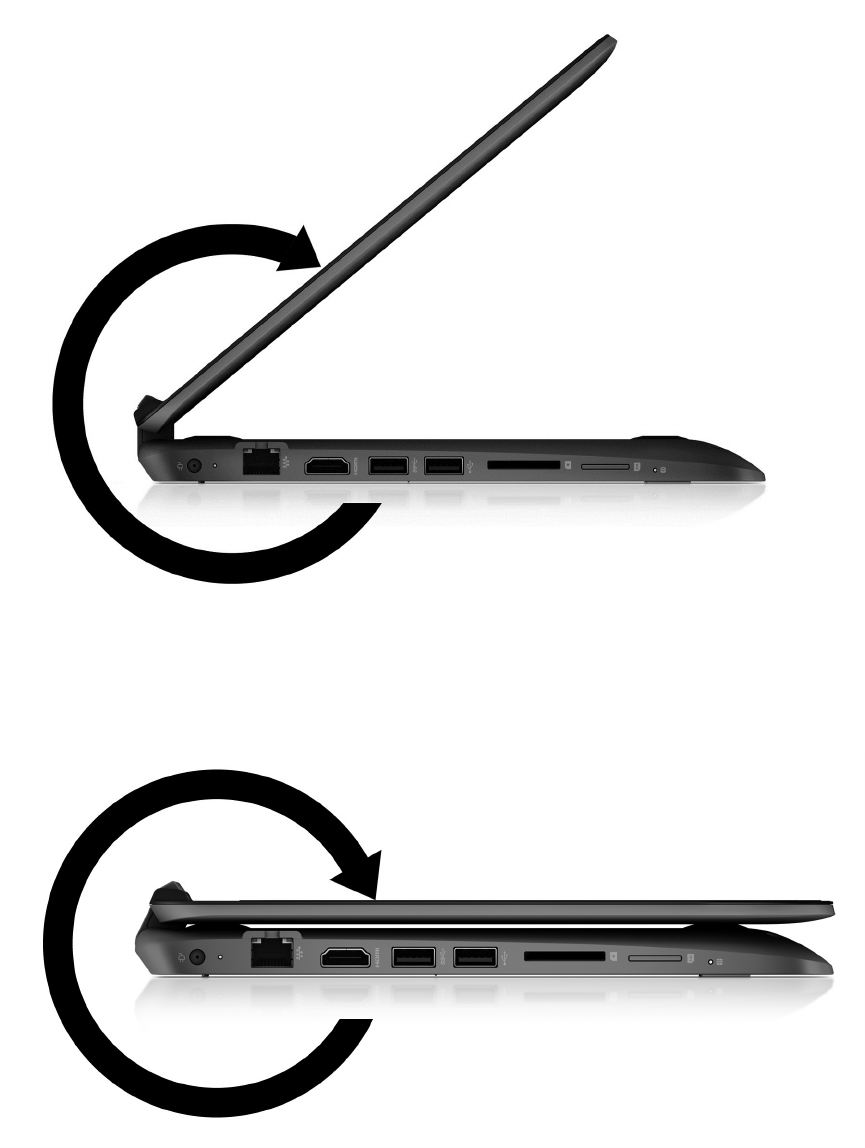
Changing your notebook to an entertainment stand
To change your notebook to an entertainment stand, raise the display, and then rotate the display
backward to a stand position (about 315 degrees).
Changing your notebook to a tablet
To change your notebook to a tablet, raise the display, and then rotate the display backward until it is
flush with the computer bottom (360 degrees).
10 Chapter 2 Getting to know your computer
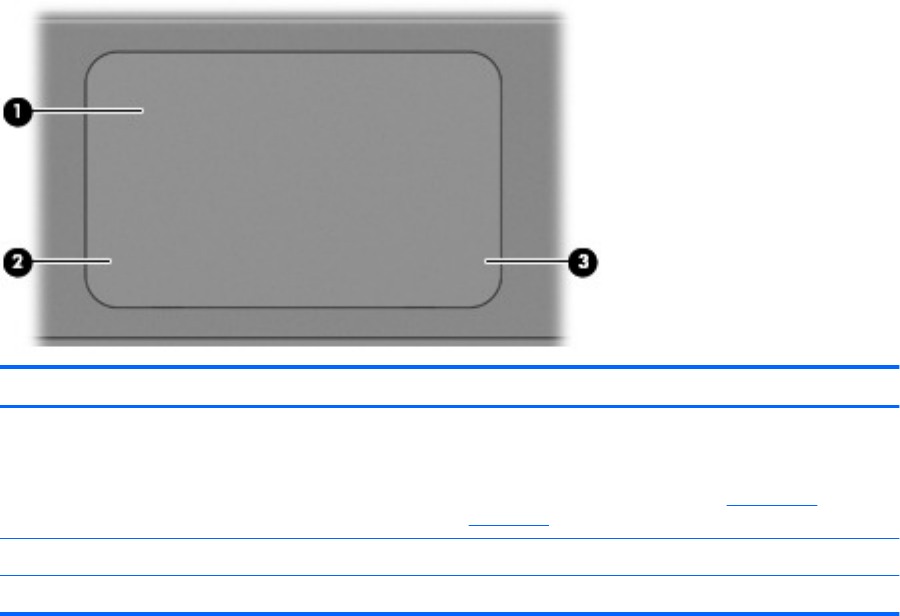
Top
TouchPad
Component Description
(1) TouchPad zone Moves the on-screen pointer and selects or activates items
on the screen.
NOTE: The TouchPad also supports edge-swipe
gestures. For more information, see Edge swipes
on page 29.
(2) Left TouchPad button Functions like the left button on an external mouse.
(3) Right TouchPad button Functions like the right button on an external mouse.
Top 11
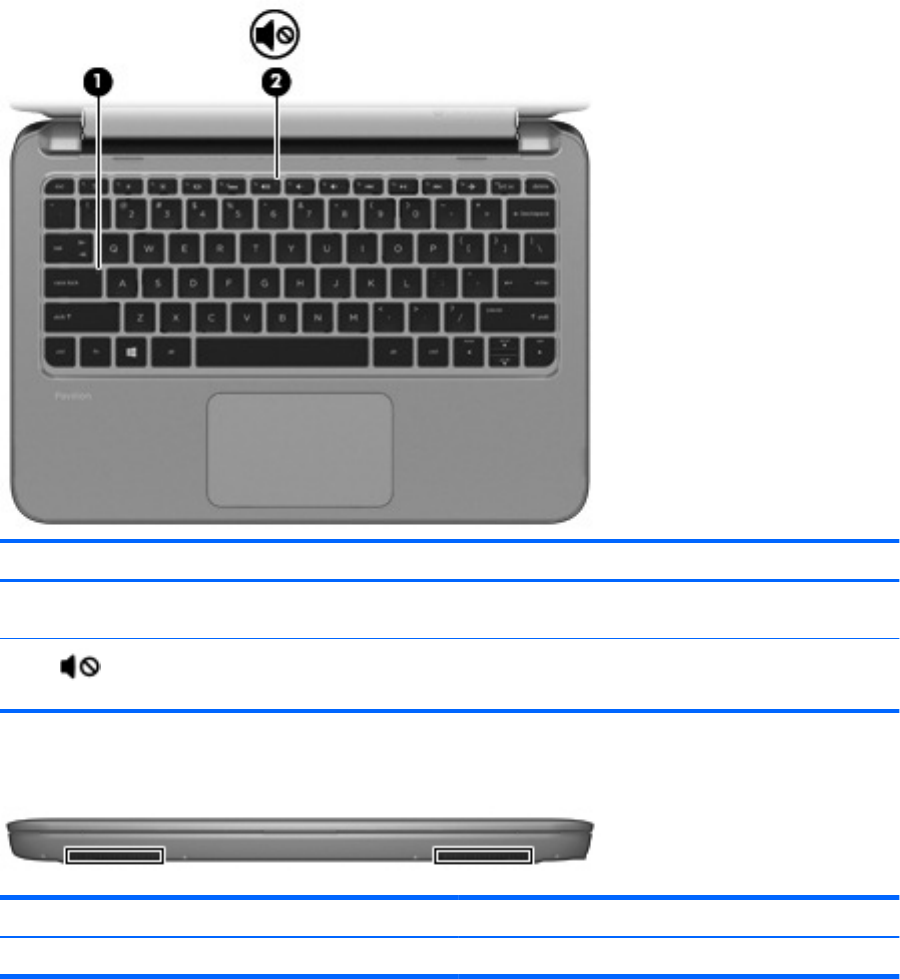
Lights
Component Description
(1) Caps lock light On: Caps lock is on, which switches the keys to all capital
letters.
(2) Mute light ●Amber: Computer sound is off.
●Off: Computer sound is on.
Speakers
Component Description
Speakers (2) Produce sound.
12 Chapter 2 Getting to know your computer
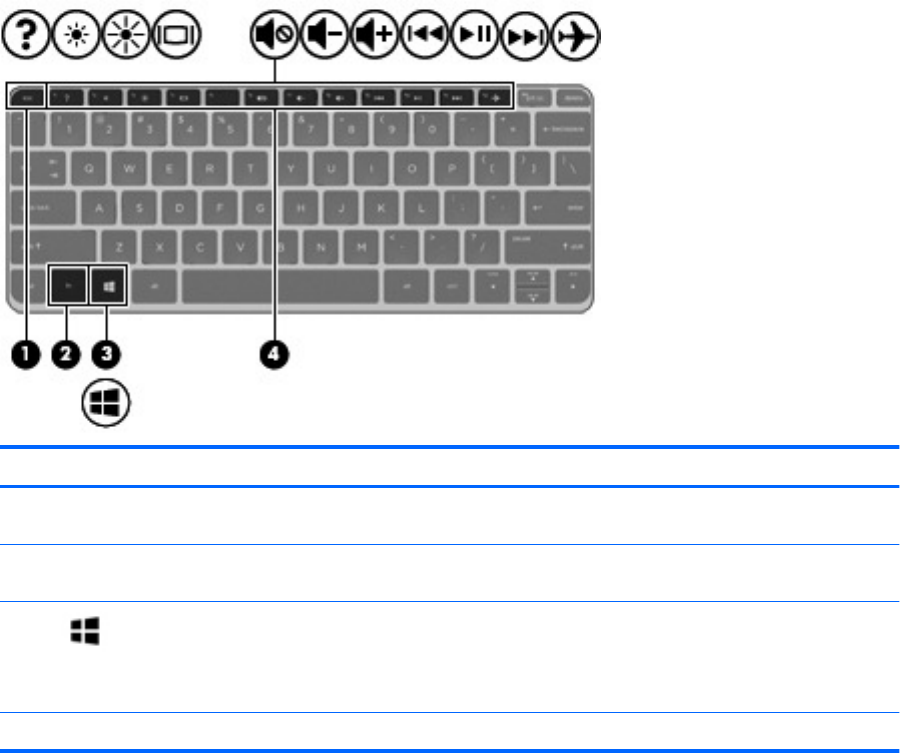
Keys
Component Description
(1) esc key Displays system information when pressed in combination
with the fn key.
(2) fn key Executes frequently used system functions when pressed
in combination with the b key, the spacebar, or the esc key.
(3) Windows key Returns you to the Start screen from an open app or the
Windows desktop.
NOTE: Pressing the Windows key again will return you to
the previous screen.
(4) Action keys Execute frequently used system functions.
Labels
Important system information is located on the bottom of the computer. The labels affixed to the
computer provide information you may need when you troubleshoot system problems or travel
internationally with the computer.
●Service labelProvides important information to identify your computer. When contacting
support, you will probably be asked for the serial number, and possibly for the product number or
the model number. Locate these numbers before you contact support.
Your service label will resemble one of the examples shown below. Refer to the illustration that
most closely matches the service label on your computer.
Labels 13
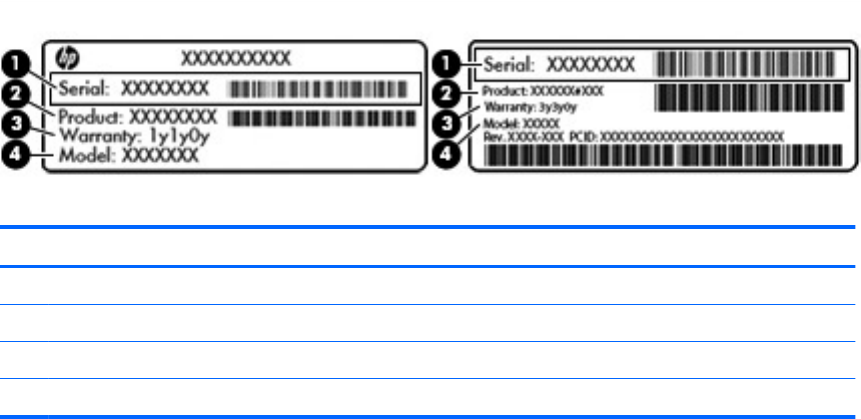
Component
(1) Serial number
(2) Product number
(3) Warranty period
(4) Model number (select models only)
●Regulatory label(s)Provide(s) regulatory information about the computer.
●Wireless certification label(s)Provide(s) information about optional wireless devices and the
approval markings for the countries or regions in which the devices have been approved for use.
14 Chapter 2 Getting to know your computer

3 Connecting to a network
Your computer can travel with you wherever you go. But even at home, you can explore the globe
and access information from millions of websites using your computer and a wired or wireless
network connection. This chapter will help you get connected to that world.
Connecting to a wireless network
Wireless technology transfers data across radio waves instead of wires. Your computer may be
equipped with one or more of the following wireless devices:
●Wireless local area network (WLAN) deviceConnects the computer to wireless local area
networks (commonly referred to as Wi-Fi networks, wireless LANs, or WLANs) in corporate
offices, your home, and public places such as airports, restaurants, coffee shops, hotels, and
universities. In a WLAN, the mobile wireless device in your computer communicates with a
wireless router or a wireless access point.
●HP Mobile Broadband Module (select models only)A wireless wide area network (WWAN)
device that gives you wireless connectivity over a much larger area. Mobile network operators
install base stations (similar to cell phone towers) throughout large geographic areas, effectively
providing coverage across entire states, regions, or even countries.
●Bluetooth® device (select models only)Creates a personal area network (PAN) to connect to
other Bluetooth-enabled devices such as computers, phones, printers, headsets, speakers, and
cameras. In a PAN, each device communicates directly with other devices, and devices must be
relatively close togethertypically within 10 meters (approximately 33 feet) of each other.
For more information about wireless technology, see the information and website links provided in
Help and Support. From the Start screen, type help, and then select Help and Support.
Using the wireless controls
You can control the wireless devices in your computer using the operating system controls. For more
information, see Help and Support. From the Start screen, type help, and then select Help and
Support.
Using the wireless button
The computer has a wireless button and one or more wireless devices, depending on the model. All
of the wireless devices on your computer are enabled at the factory, so the wireless devices are on
when you turn on the computer.
Because the wireless devices are enabled at the factory, you can use the wireless button to turn on or
turn off the wireless devices simultaneously.
Connecting to a wireless network 15

Using operating system controls
The Network and Sharing Center allows you to set up a connection or network, connect to a network,
and diagnose and repair network problems.
To use operating system controls:
1. From the Start screen, type control panel, and then select Control Panel.
2. Select Network and Internet, and then select Network and Sharing Center.
For more information, from the Start screen, type help, and then select Help and Support.
Sharing data and drives and accessing software
When your computer is part of a network, you are not limited to using only the information that is
stored in your computer. Network computers can exchange software and data with each other.
NOTE: When a disc like a DVD movie or game is copy-protected, it cannot be shared.
To share folders or content on the same network:
1. From the Windows desktop, open File Explorer.
2. From This PC, click a folder with content you want to share. Select Share from the navigation
bar at the top of the window, and then click Specific people.
3. Type a name in the File Sharing box, and then click Add.
4. Click Share and then follow the on-screen instructions.
To share drives on the same network:
1. From the Windows desktop, right-click the network status icon in the notification area, at the far
right of the taskbar.
2. Select Open Network and Sharing Center.
3. Under View your active networks, select an active network.
4. Select Change advanced sharing settings to set sharing options for privacy, network discovery,
file and printer sharing or other network options.
Using a WLAN
With a WLAN device, you can access a wireless local area network (WLAN), which is composed of
other computers and accessories that are linked by a wireless router or a wireless access point.
NOTE: The terms
wireless router
and
wireless access point
are often used interchangeably.
●A large-scale WLAN, such as a corporate or public WLAN, typically uses wireless access points
that can accommodate a large number of computers and accessories and can separate critical
network functions.
●A home or small office WLAN typically uses a wireless router, which allows several wireless and
wired computers to share an Internet connection, a printer, and files without requiring additional
pieces of hardware or software.
To use the WLAN device in your computer, you must connect to a WLAN infrastructure (provided
through a service provider or a public or corporate network).
16 Chapter 3 Connecting to a network
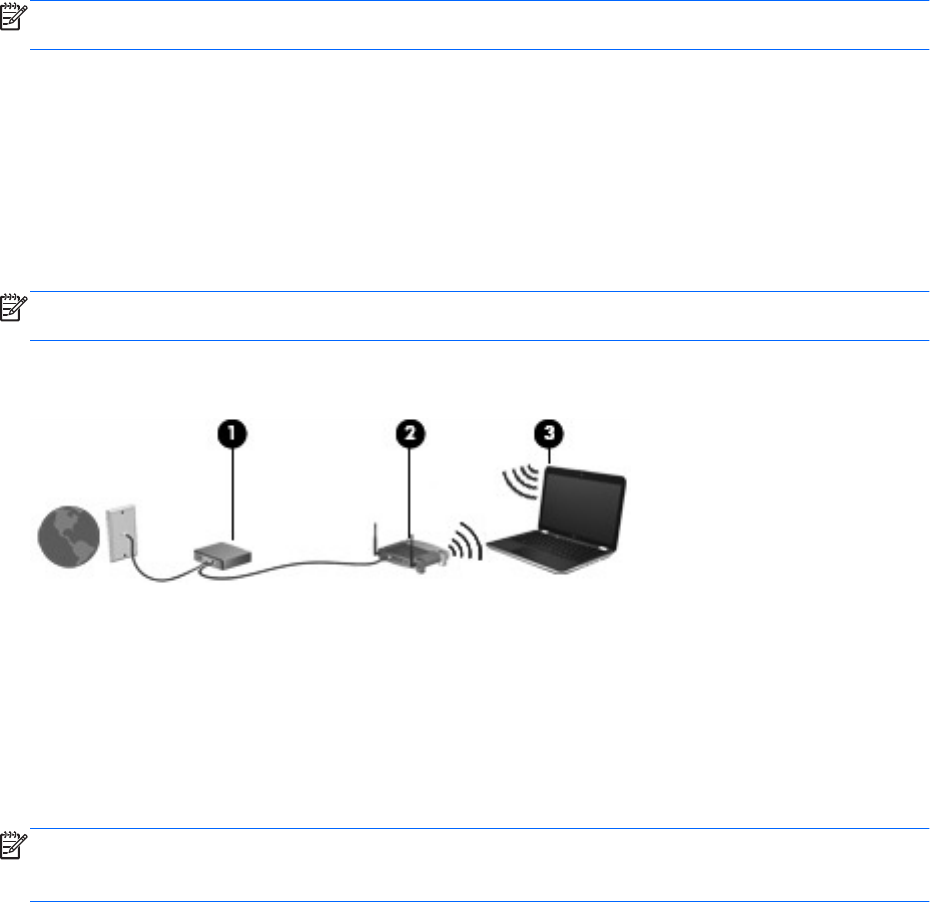
Using an Internet service provider
When you are setting up Internet access in your home, you must establish an account with an
Internet service provider (ISP). To purchase Internet service and a modem, contact a local ISP. The
ISP will help set up the modem, install a network cable to connect your wireless router to the modem,
and test the Internet service.
NOTE: Your ISP will give you a user ID and a password to use for Internet access. Record this
information and store it in a safe place.
Setting up a WLAN
To set up a WLAN and connect to the Internet, you need the following equipment:
●A broadband modem (either DSL or cable) (1) and high-speed Internet service purchased from
an Internet service provider
●A wireless router (2) (purchased separately)
●A wireless computer (3)
NOTE: Some modems have a built-in wireless router. Check with your ISP to determine what type
of modem you have.
The illustration below shows an example of a wireless network installation that is connected to the
Internet.
As your network grows, additional wireless and wired computers can be connected to the network to
access the Internet.
For help in setting up your WLAN, see the information provided by your router manufacturer or your
ISP.
Configuring a wireless router
For help in configuring a wireless router, see the information provided by your router manufacturer or
your ISP.
NOTE: It is recommended that you initially connect your new wireless computer to the router by
using the network cable provided with the router. When the computer successfully connects to the
Internet, disconnect the cable, and access the Internet through your wireless network.
Protecting your WLAN
When you set up a WLAN or access an existing WLAN, always enable security features to protect
your network from unauthorized access. WLANs in public areas (hotspots) like coffee shops and
airports may not provide any security. If you are concerned about the security of your computer when
connected to a hotspot, limit your network activities to email that is not confidential and basic Internet
surfing.
Wireless radio signals travel outside the network, so other WLAN devices can pick up unprotected
signals. Take the following precautions to protect your WLAN:
Connecting to a wireless network 17

●Use a firewall.
A firewall checks information and requests that are sent to your network, and discards any
suspicious items. Firewalls are available in both software and hardware. Some networks use a
combination of both types.
●Use wireless encryption.
Wireless encryption uses security settings to encrypt and decrypt data that is transmitted over
the network. For more information, from the Start screen, type help, and then select Help and
Support.
Connecting to a WLAN
To connect to the WLAN, follow these steps:
1. Be sure that the WLAN device is on. If the device is off, the airplane mode icon displays on the
Windows desktop; press the wireless button to turn the WLAN device on.
2. From the Start screen, point to the far-right upper or lower corner of the screen to display the
charms.
3. Select Settings, and then click the network status icon.
4. Select your WLAN from the list.
5. Click Connect.
If the WLAN is a security-enabled WLAN, you are prompted to enter a security code. Type the
code, and then click Sign in to complete the connection.
NOTE: If no WLANs are listed, you may be out of range of a wireless router or access point.
NOTE: If you do not see the WLAN you want to connect to, from the Windows desktop, right-
click the network status icon, and then select Open Network and Sharing Center. Click Set up a
new connection or network. A list of options is displayed, allowing you to manually search for
and connect to a network or to create a new network connection.
6. Follow the on-screen instructions to complete the connection.
After the connection is made, place the mouse pointer over the network status icon in the notification
area, at the far right of the taskbar, to verify the name and status of the connection.
NOTE: The functional range (how far your wireless signals travel) depends on WLAN
implementation, router manufacturer, and interference from other electronic devices or structural
barriers such as walls and floors.
Using HP Mobile Broadband (select models only)
HP Mobile Broadband enables your computer to use WWANs to access the Internet from more
places and over larger areas than it can by using WLANs. Using HP Mobile Broadband requires a
network service provider (called a
mobile network operator
), which in most cases is a cellular phone
network operator. Coverage for HP Mobile Broadband is similar to cellular phone voice coverage.
When used with mobile network operator service, HP Mobile Broadband gives you the freedom to
stay connected to the Internet, send email, or connect to your corporate network whether you are on
the road or outside the range of Wi-Fi hotspots.
HP supports the following technologies:
18 Chapter 3 Connecting to a network
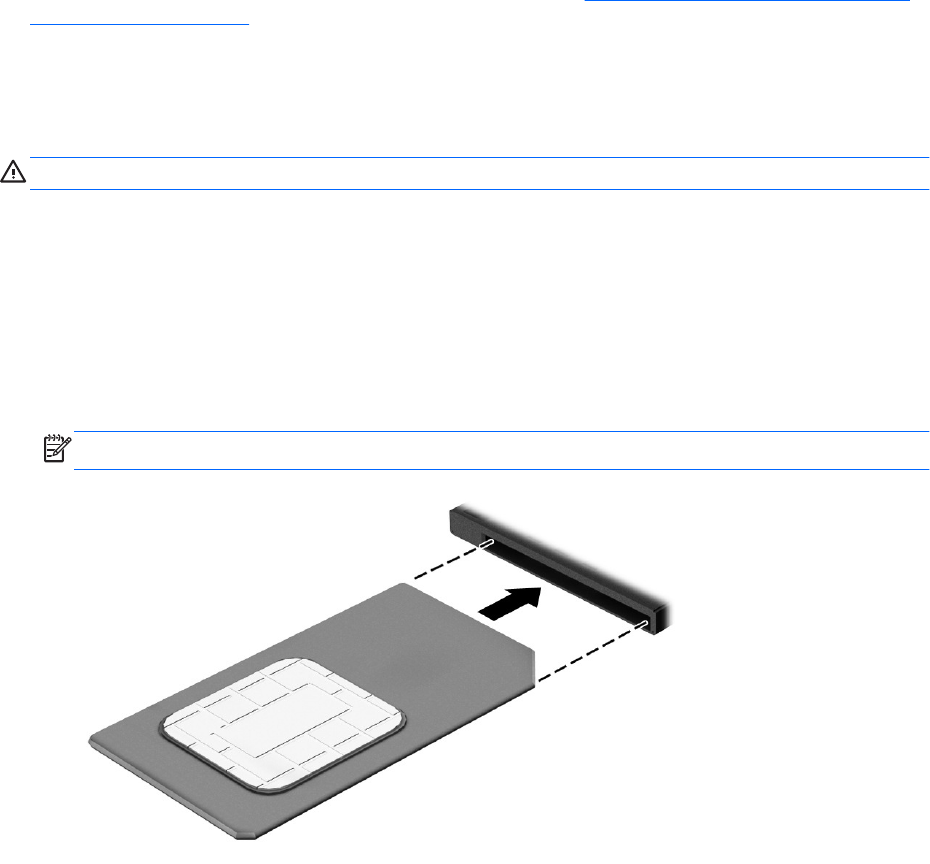
●HSPA (High Speed Packet Access), which provides access to networks based on the Global
System for Mobile Communications (GSM) telecommunications standard.
●EV-DO (Evolution Data Optimized), which provides access to networks based on the code
division multiple access (CDMA) telecommunications standard.
●LTE (Long Term Evolution), which provides access to networks supporting LTE technology.
You might need the HP Mobile Broadband Module IMEI and/or MEID number to activate mobile
broadband service. The serial number is printed on a label located on the bottom of your computer.
Some mobile network operators require the use of a subscriber identity module (SIM). A SIM contains
basic information about you, such as a personal identification number (PIN), as well as network
information. If the SIM is not preinstalled, it may be provided in the HP Mobile Broadband information
provided with your computer or the mobile network operator may provide it separately from the
computer.
For information about inserting and removing the SIM, see the Inserting and removing a SIM (select
models only) on page 19 section in this chapter.
For information about HP Mobile Broadband and how to activate service with a preferred mobile
network operator, see the HP Mobile Broadband information included with your computer.
Inserting and removing a SIM (select models only)
CAUTION: To prevent damage to the connectors, use minimal force when inserting a SIM.
To insert a SIM, follow these steps:
1. Shut down the computer.
2. Close the display.
3. Disconnect all external devices connected to the computer.
4. Unplug the power cord from the AC outlet.
5. Insert the SIM into the SIM slot, and then gently push the SIM into the slot until it is firmly seated.
NOTE: The SIM in your computer may look slightly different from the illustration in this section.
6. Reconnect external power.
Connecting to a wireless network 19
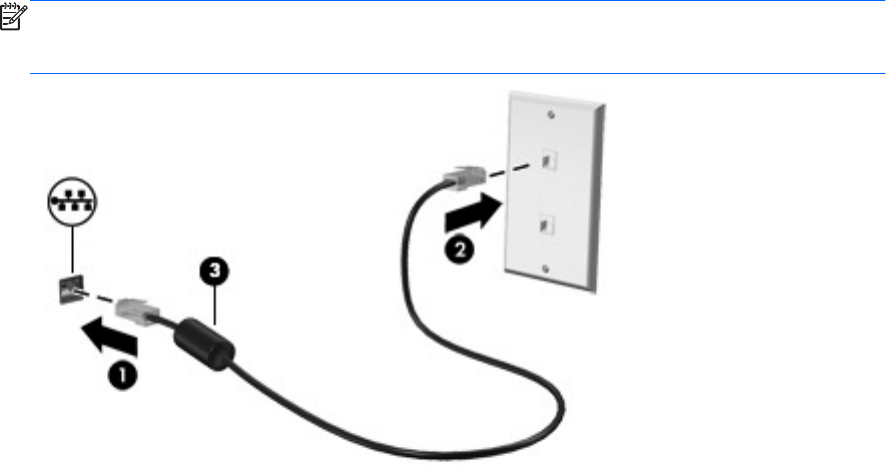
7. Reconnect external devices.
8. Turn on the computer.
To remove a SIM, press in on the SIM, and then remove it from the slot.
Using Bluetooth wireless devices (select models only)
A Bluetooth device provides short-range wireless communications that replace the physical cable
connections that traditionally link electronic devices such as the following:
●Computers (desktop, notebook, PDA)
●Phones (cellular, cordless, smart phone)
●Imaging devices (printer, camera)
●Audio devices (headset, speakers)
●Mouse
Bluetooth devices provide peer-to-peer capability that allows you to set up a PAN of Bluetooth
devices. For information about configuring and using Bluetooth devices, see the Bluetooth software
Help.
Connecting to a wired network
Connecting to a local area network (LAN)
Use a LAN connection if you want to connect the computer directly to a router in your home (instead
of working wirelessly), or if you want to connect to an existing network at your office.
Connecting to a LAN requires an 8-pin, RJ-45 (network) cable.
To connect the network cable, follow these steps:
1. Plug the network cable into the network jack (1) on the computer.
2. Plug the other end of the network cable into a network wall jack (2) or router.
NOTE: If the network cable contains noise suppression circuitry (3), which prevents
interference from TV and radio reception, orient the circuitry end of the cable toward the
computer.
20 Chapter 3 Connecting to a network
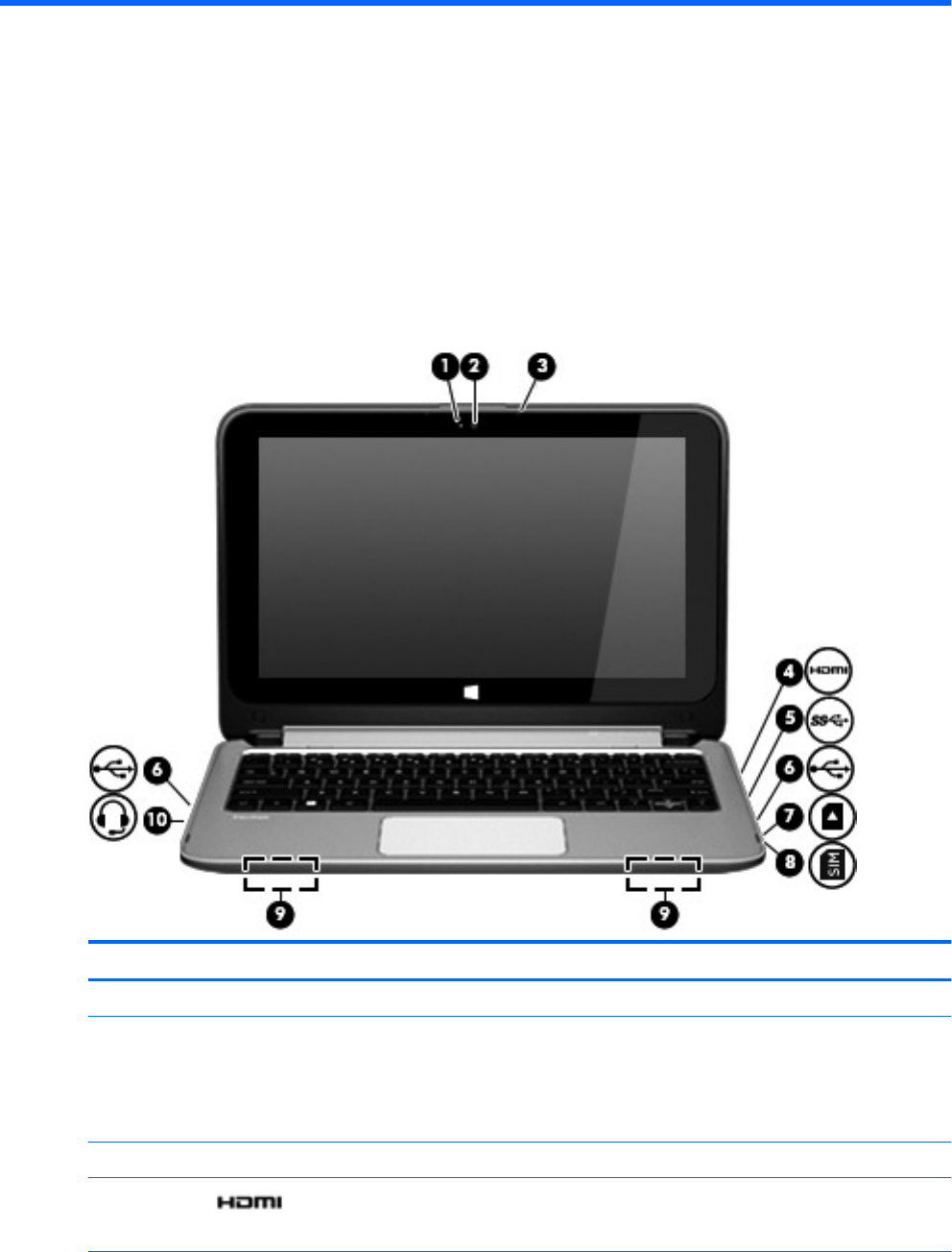
4 Enjoying entertainment features
Use your HP computer as an entertainment hub to socialize via the webcam, enjoy and manage your
music, and download and watch movies. Or, to make your computer an even more powerful
entertainment center, connect external devices like a monitor, projector, or TV, or speakers and
headphones.
Multimedia features
Here are some of the entertainment features on your computer.
Component Description
(1) Webcam light On: The webcam is in use.
(2) Webcam Records video and captures photographs. Some
models allow you to video conference and chat
online using streaming video.
From the Start screen, type camera, and then select
Camera from the list of applications.
(3) Internal microphone Records sound.
(4) HDMI port Connects an optional video or audio device, such as
a high-definition television, any compatible digital or
audio component, or a high-speed HDMI device.
Multimedia features 21
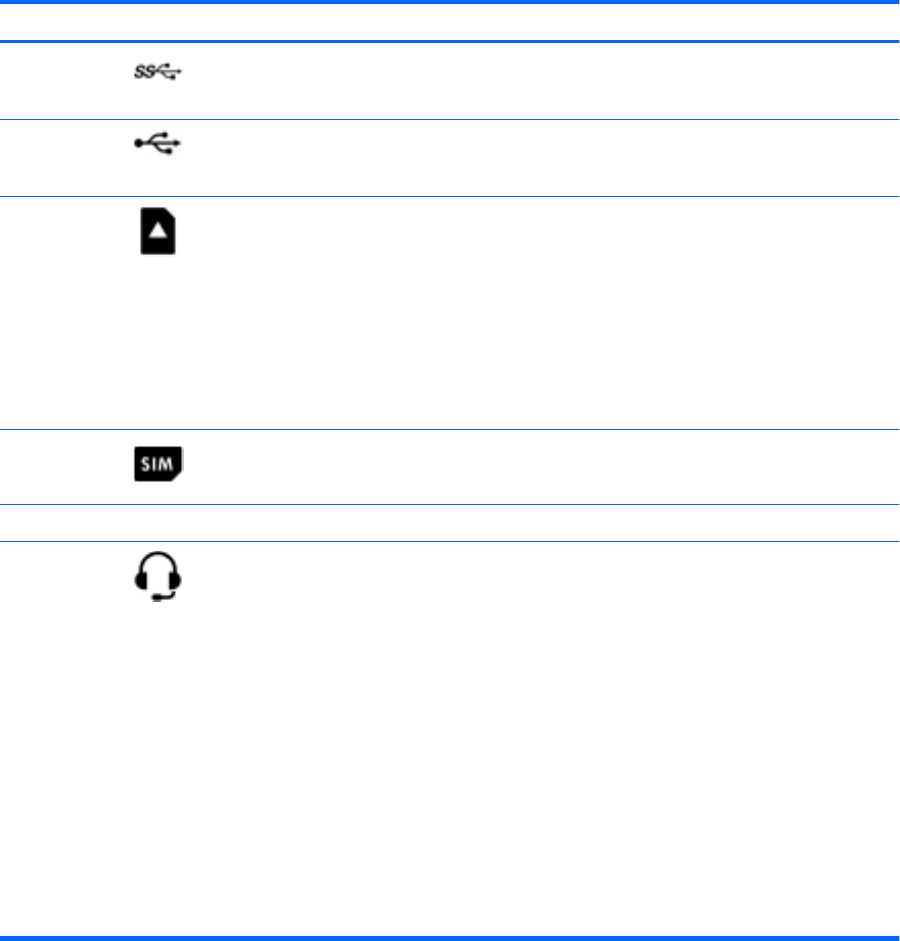
Component Description
(5) USB 3.0 port Connects an optional USB device, such as a
keyboard, mouse, external drive, printer, scanner or
USB hub.
(6) USB 2.0 ports Connect an optional USB device, such as a
keyboard, mouse, external drive, printer, scanner or
USB hub.
(7) Memory card reader Reads optional memory cards that store, manage,
share, or access information.
To insert a card:
Hold the card label-side up, with connectors facing
the slot, insert the card into the slot, and then push
in on the card until it is firmly seated.
To remove a card:
Press in on the card it until it pops out.
(8) SIM slot (select models only) Supports a wireless subscriber identity module
(SIM).
(9) Speakers (2) Produce sound.
(10) Audio-out (headphone)/Audio-in
(microphone) jack
Connects optional powered stereo speakers,
headphones, earbuds, a headset, or a television
audio cable. Also connects an optional headset
microphone. This jack does not support optional
microphone-only devices.
WARNING! To reduce the risk of personal injury,
adjust the volume before putting on headphones,
earbuds, or a headset. For additional safety
information, refer to the
Regulatory, Safety, and
Environmental Notices
. To access this guide, from
the Start screen, type support, and then select the
HP Support Assistant app.
NOTE: When a device is connected to the jack,
the computer speakers are disabled.
NOTE: Be sure that the device cable has a 4-
conductor connector that supports both audio-out
(headphone) and audio-in (microphone).
Using the webcam
The computer has an integrated webcam that records video and captures photographs. Some models
may allow you to video conference and chat online using streaming video.
▲To start the webcam, from the Start screen, type camera, and then select Camera from the list
of applications.
For details about using the webcam, go to Help and Support. From the Start screen, type help, and
then select Help and Support.
22 Chapter 4 Enjoying entertainment features

Using audio
On your computer, you can download and listen to music, stream audio content from the web
(including radio), record audio, or mix audio and video to create multimedia. To enhance your
listening enjoyment, attach external audio devices such as speakers or headphones.
Connecting speakers
You can attach wired speakers to your computer by connecting them to a USB port or to the audio-
out (headphone)/audio-in (microphone) jack on your computer or on a docking station.
To connect
wireless
speakers to your computer, follow the device manufacturer's instructions. To
connect high-definition speakers to the computer, see Setting up HDMI audio on page 25. Before
connecting speakers, lower the volume setting.
Connecting headphones and microphones
You can connect wired headphones or headsets to the audio-out (headphone)/audio-in (microphone)
jack on your computer. Many headsets with integrated microphones are commercially available.
To connect
wireless
headphones or headsets to your computer, follow the device manufacturer's
instructions.
WARNING! To reduce the risk of personal injury, lower the volume setting before putting on
headphones, earbuds, or a headset. For additional safety information, see the
Regulatory, Safety and
Environmental Notices
. To access this guide, from the Start screen, type support, and then select
the HP Support Assistant app.
Using Beats Audio
Beats Audio is an enhanced audio feature that provides a deep, controlled bass while maintaining a
clear sound. You can experience Beats Audio through the computer's internal speakers, through
external speakers connected to a USB port, or through Beats Audio headphones connected to the
headphone jack.
Accessing Beats Audio Control Panel
Use Beats Audio Control Panel to view and manually control audio and bass settings.
▲From Start screen, type c, select Control Panel, select Hardware and Sound, and then select
Beats Audio Control Panel.
Enabling and disabling Beats Audio
▲To enable or disable Beats Audio, press the fn key in combination with the b key.
Testing your audio features
To check the audio functions on your computer, follow these steps:
1. From the Start screen, type control panel, and then select Control Panel.
2. Select Hardware and Sound, and then select Sound.
3. When the Sound window opens, select the Sounds tab. Under Program Events, select any
sound event, such as a beep or alarm, and then click Test.
You should hear sound through the speakers or through connected headphones.
Using audio 23
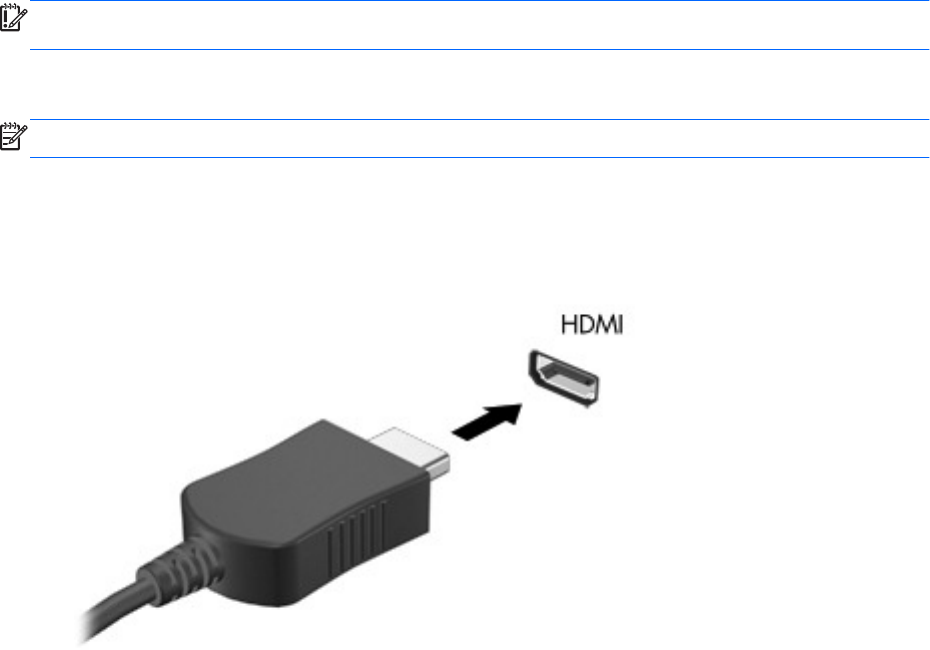
To check the recording functions on your computer, follow these steps:
1. From the Start screen, type sound, and then select Sound Recorder.
2. Click Start Recording and speak into the microphone.
3. Save the file to your desktop.
4. Open a multimedia program and play the recording.
To confirm or change the audio settings on your computer, follow these steps:
1. From the Start screen, type control panel, and then select Control Panel.
2. Select Hardware and Sound, and then select Sound.
Using video
Your computer is a powerful video device that enables you to watch streaming video from your
favorite websites and download video and movies to watch on your computer when you are not
connected to a network.
To enhance your viewing enjoyment, use one of the video ports on the computer to connect an
external monitor, projector, or TV. Your computer has a high-definition multimedia interface (HDMI)
port, which allows you to connect a high-definition monitor or TV.
IMPORTANT: Be sure that the external device is connected to the correct port on the computer,
using the correct cable. Check the device manufacturer's instructions.
Connecting video devices by using an HDMI cable
NOTE: To connect an HDMI device to your computer, you need an HDMI cable, sold separately.
To see the computer screen image on a high-definition TV or monitor, connect the high-definition
device according to the following instructions.
1. Connect one end of the HDMI cable to the HDMI port on the computer.
2. Connect the other end of the cable to the high-definition TV or monitor.
3. Press f4 to alternate the computer screen image between 4 display states:
24 Chapter 4 Enjoying entertainment features

●PC screen only: View the screen image on the computer only.
●Duplicate: View the screen image simultaneously on
both
the computer and the external
device.
●Extend: View the screen image extended across
both
the computer and the external
device.
●Second screen only: View the screen image on the external device only.
Each time you press f4, the display state changes.
NOTE: For best results, especially if you choose the Extend option, adjust the screen
resolution of the external device, as follows. From the Start screen, type control panel, and
then select Control Panel. Select Appearance and Personalization. Under Display, select Adjust
screen resolution.
Setting up HDMI audio
HDMI is the only video interface that supports high-definition video
and
audio. After you connect an
HDMI TV to the computer, you can then turn on HDMI audio by following these steps:
1. From the Windows desktop, right-click the Speakers icon in the notification area, at the far right
of the taskbar, and then select Playback devices.
2. On the Playback tab, select the name of the digital output device.
3. Click Set Default, and then click OK.
To return the audio stream to the computer speakers:
1. From the Windows desktop, right-click the Speakers icon in the notification area, at the far right
of the taskbar, and then click Playback devices.
2. On the Playback tab, click Speakers.
3. Click Set Default, and then click OK.
Discovering and connecting to Miracast-compatible wireless displays
To discover and connect to Miracast-compatible wireless displays without leaving your current apps,
follow the steps below.
To open Miracast:
▲Swipe from the right edge of the Start screen, tap Devices, tap Project, and then follow the on-
screen instructions.
or
Point to the upper-right or lower-right corner of the Start screen to display the charms, click
Devices, click Project, and then follow the on-screen instructions.
Using video 25

5 Navigating the screen
You can navigate the computer screen in the following ways:
●Touch gestures
●Keyboard and mouse
Touch gestures can be used on your computer TouchPad or on a touch screen.
NOTE: An external USB mouse (purchased separately) can be connected to one of the USB ports
on the computer.
Review the
Windows Basics
guide included with your computer. The guide provides information
about common tasks using the TouchPad, touch screen, or the keyboard.
Your computer model has special action keys or hot key functions on the keyboard to perform routine
tasks.
Using the TouchPad and gestures
The TouchPad allows you to navigate the computer screen and control the pointer by using simple
finger movements. You can customize the touch gestures by changing settings, button configurations,
click speed, and pointer options. You can also view demonstrations of TouchPad gestures.
From the Start screen, type control panel, select Control Panel, and then select Hardware and
Sound. Under Devices and Printers, select Mouse.
TIP: Use the left and right buttons on the TouchPad as you would use the corresponding buttons on
an external mouse.
NOTE: TouchPad gestures are not supported in all apps.
26 Chapter 5 Navigating the screen
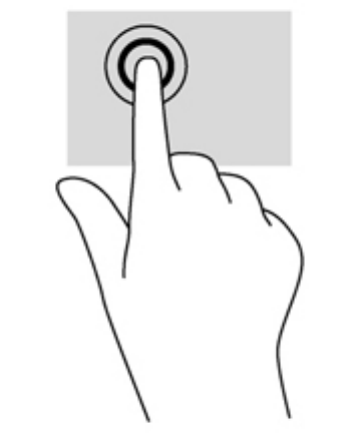
Tapping
To make an on-screen selection, use the tap function on the TouchPad.
●Point to an item on the screen, and then tap one finger on the TouchPad zone to make a
selection. Double-tap an item to open it.
Using the TouchPad and gestures 27

Scrolling
Scrolling is useful for moving up, down, or sideways on a page or image.
●Place two fingers slightly apart on the TouchPad zone and then drag them up, down, left, or
right.
2-finger pinch zoom
2-finger pinch zoom allows you to zoom out or in on images or text.
●Zoom out by placing two fingers apart on the TouchPad zone and then moving your fingers
together.
●Zoom in by placing two fingers together on the TouchPad zone and then moving your fingers
apart.
28 Chapter 5 Navigating the screen
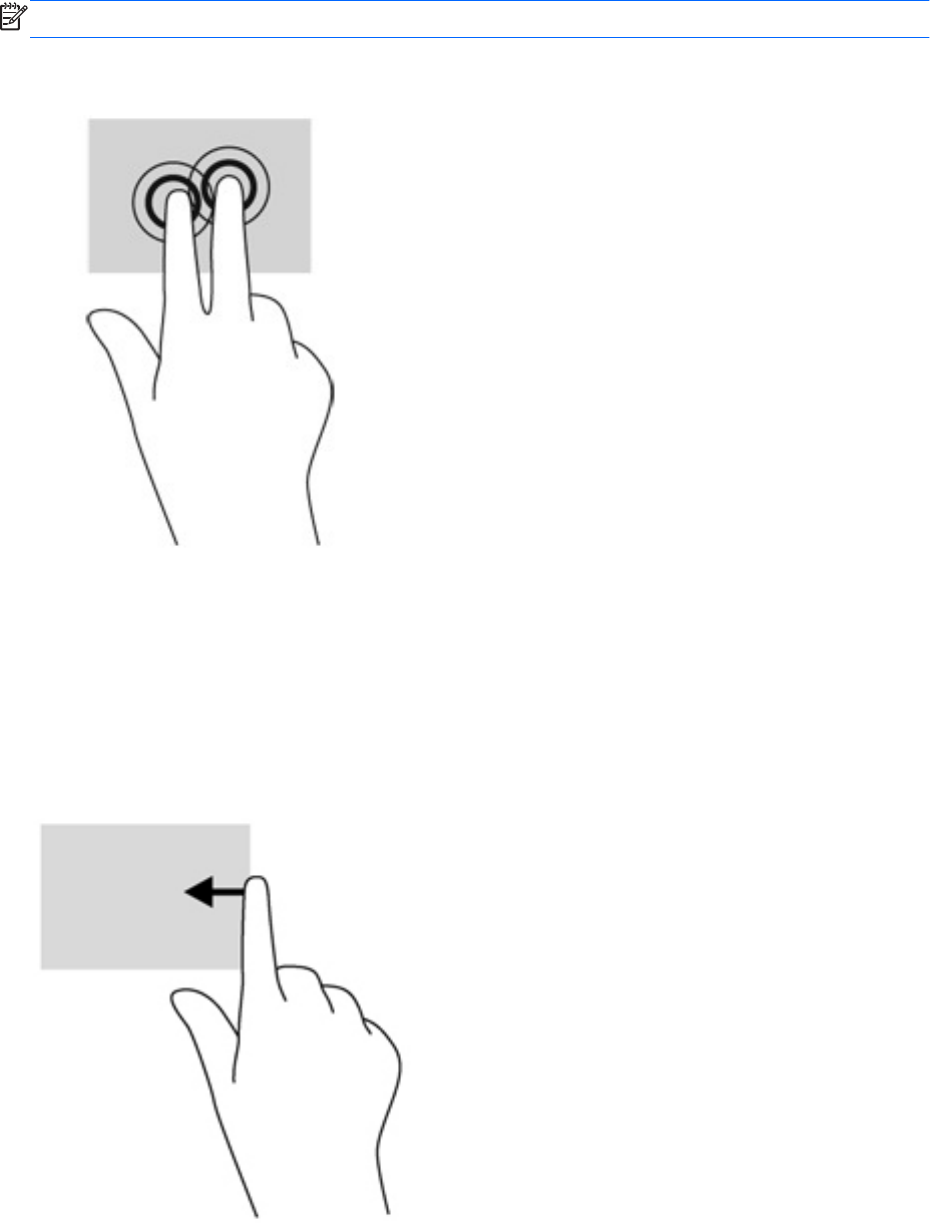
2-finger click
2-finger click allows you to make menu selections for an object on the screen.
NOTE: Using 2-finger click is the same action as using right-click with the mouse.
●Place two fingers on the TouchPad zone and press down to open the options menu for the
selected object.
Edge swipes
Edge swipes allow you to perform tasks such as changing settings and finding or using apps.
Right-edge swipe
The right-edge swipe reveals the charms, which let you search, share, start apps, access devices, or
change settings.
●Swipe your finger gently from the right edge to reveal the charms.
Using the TouchPad and gestures 29
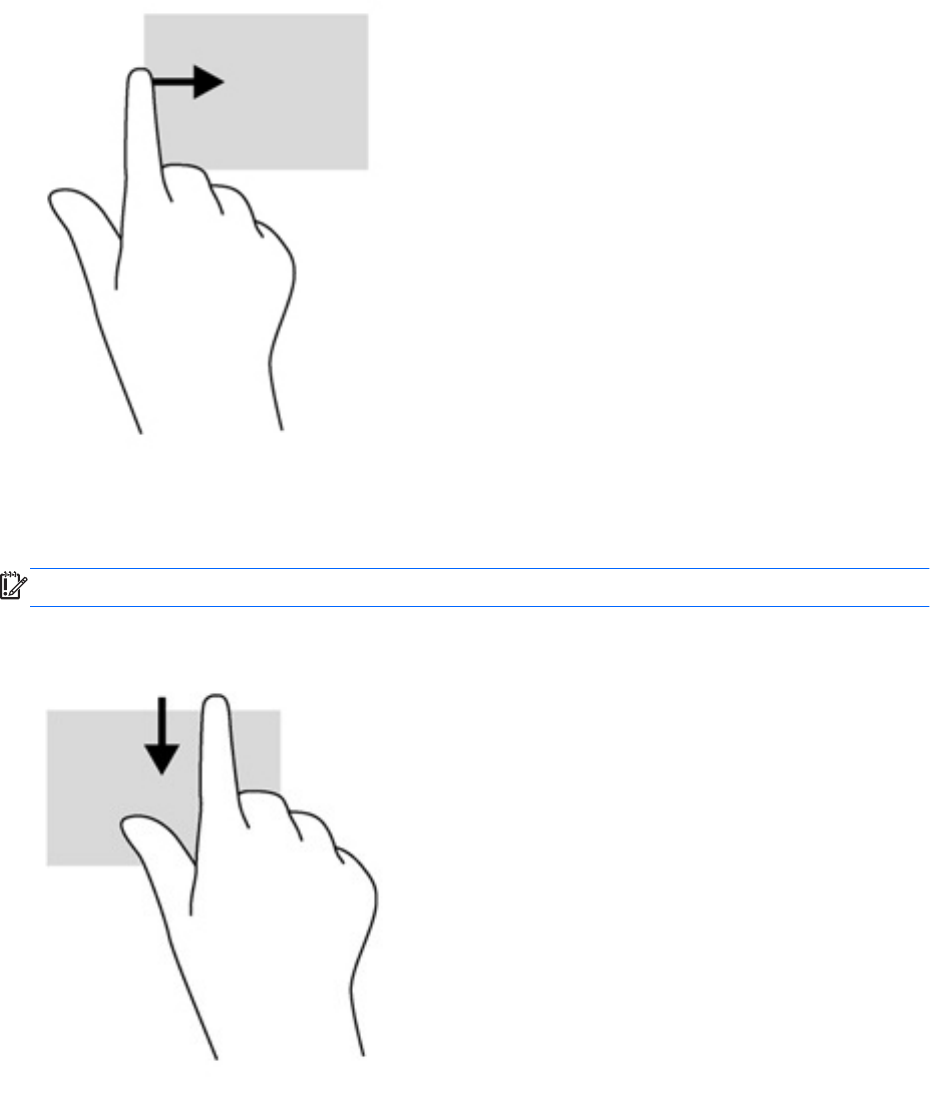
Left-edge swipe
The left-edge swipe accesses your recently opened apps so that you can switch between them
quickly.
●Swipe your finger gently from the left edge of the TouchPad.
Top-edge swipe
The top-edge swipe displays app command options that allow you to customize apps.
IMPORTANT: When an app is active, the top-edge gesture varies depending on the app.
●Gently swipe your gently from the top edge to reveal the app command options.
30 Chapter 5 Navigating the screen
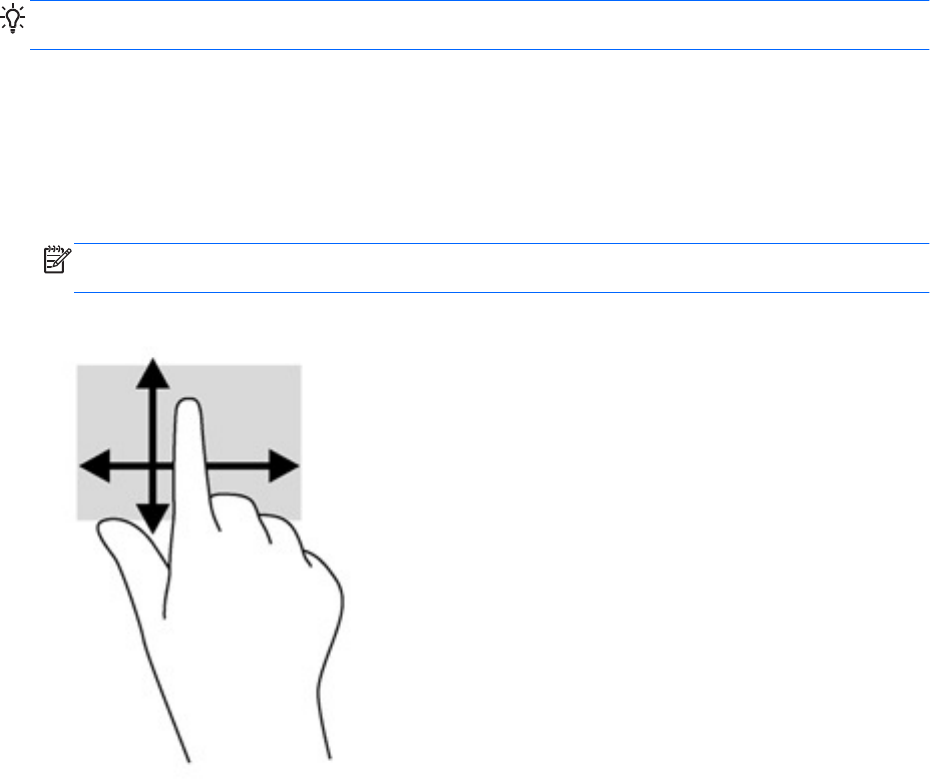
Using touch screen gestures
A touch screen computer allows you to control items on the screen directly with your fingers.
TIP: On touch screen computers, you can perform the gestures on the screen or on the TouchPad.
You can also perform on-screen actions with the keyboard and mouse.
One-finger slide
The one-finger slide is mostly used to pan or scroll through lists and pages, but you can use it for
other interactions, too, such as moving an object.
●To scroll across the screen, lightly slide one finger across the screen in the direction you want to
move.
NOTE: When many apps are displayed on the Start screen, you can slide your finger to move
the screen left or right.
●To drag, press and hold an object, and then drag the object to move it.
Using touch screen gestures 31
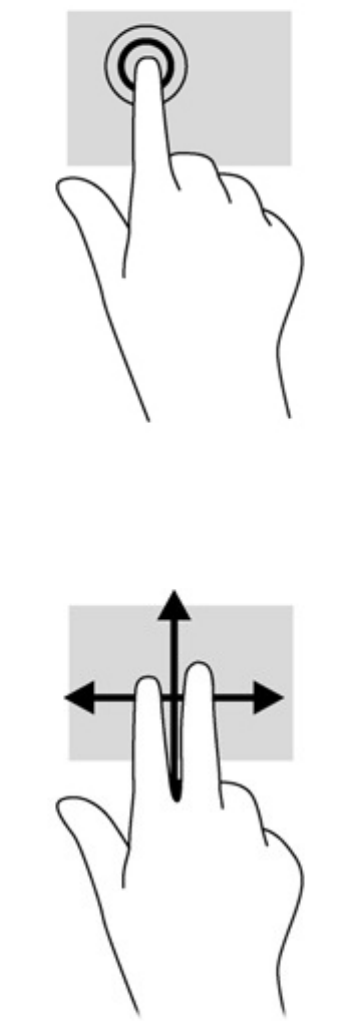
Tapping
To make an on-screen selection, use the tap function.
●Use one finger to tap an object on the screen to make a selection. Double-tap an item to open it.
Scrolling
Scrolling is useful for moving the pointer up, down, left, or right on a page or image.
●Place two fingers on the screen and then drag them in an up, down, left, or right motion.
32 Chapter 5 Navigating the screen
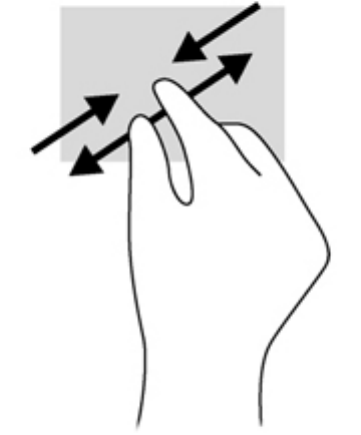
2-finger pinch zoom
2-finger pinch zoom allows you to zoom out or in on images or text.
●Zoom out by placing two fingers apart on the screen and then moving your fingers together.
●Zoom in by placing two fingers together on the screen and then moving your fingers apart.
Using touch screen gestures 33
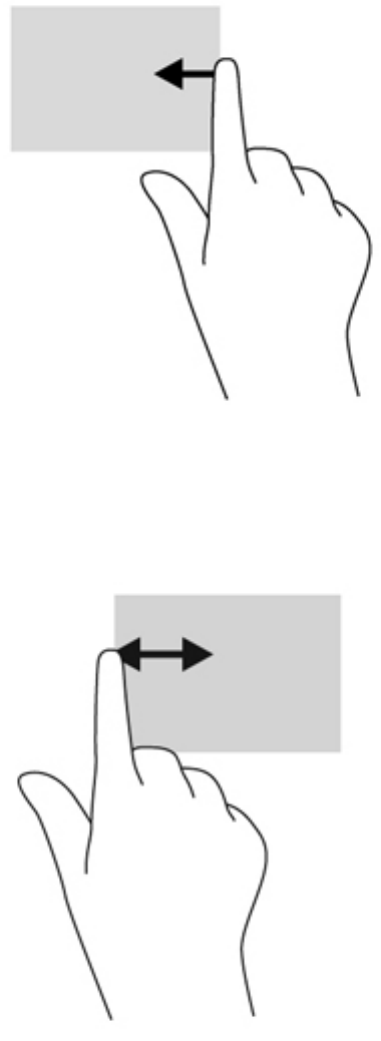
Edge swipes
With edge swipes you can perform tasks such as changing settings and finding or using apps.
Right-edge swipe
The right-edge swipe reveals the charms, which let you search, share, start apps, access devices, or
change settings.
●Gently swipe your finger inward from the right edge of the display onto the screen to reveal the
charms.
Left-edge swipe
The left-edge swipe reveals your open apps so that you can switch to them quickly.
●Gently swipe your finger inward from the left edge of the display to switch between apps.
Without lifting your finger, swipe back toward the left edge to reveal all open apps.
34 Chapter 5 Navigating the screen
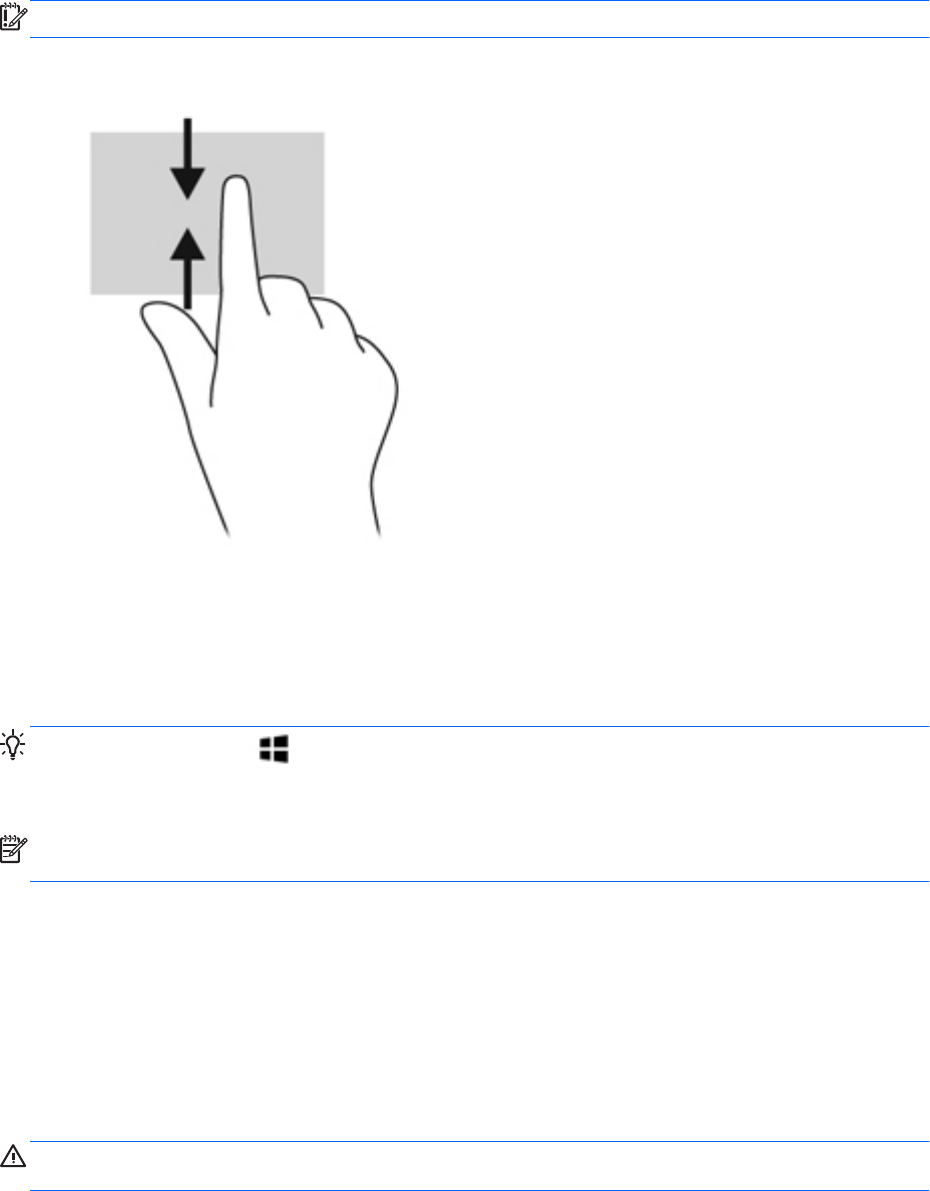
Top-edge swipe and bottom-edge swipe
The top-edge swipe or bottom-edge swipe displays app command options that allow you to customize
apps.
IMPORTANT: When an app is open, the top-edge gesture varies depending on the app.
●Gently swipe your finger from the top edge or the bottom edge to reveal the app command
options.
Using the keyboard and mouse
The keyboard and mouse allow you to type, select items, scroll and to perform the same functions as
you do using touch gestures. The keyboard also allows you to use action keys and hot keys to
perform specific functions.
TIP: The Windows key on the keyboard allows you to quickly return to the Start screen from
an open app or the Windows desktop. Pressing the Windows key again will return you to the previous
screen.
NOTE: Depending on the country or region, your keyboard may have different keys and keyboard
functions than those discussed in this section.
Using the keys
You can quickly access information or perform functions by using certain keys and key combinations.
Using the action keys
An action key performs an assigned function. The icon on each of the f1 through f4 keys and the f6
through f12 keys illustrates the assigned function for that key.
To use an action key function, press and hold the key.
CAUTION: Use extreme care when making changes in Setup Utility (BIOS). Errors can prevent the
computer from operating properly.
Using the keyboard and mouse 35

The action key feature is enabled at the factory. You can disable this feature in Setup Utility (BIOS).
See Using Setup Utility (BIOS) and HP PC Hardware Diagnostics (UEFI) on page 53 for
instructions on opening Setup Utility (BIOS), and then follow the instructions at the bottom of the
screen.
After you have disabled the action key feature, you can still perform each function by pressing the fn
key in combination with the appropriate action key.
Icon Key Description
f1 Opens Help and Support, which provides tutorials, information about the Windows
operating system and your computer, answers to questions, and updates to your
computer.
Help and Support also provides automated troubleshooting tools and access to
support.
f2 Decreases the screen brightness incrementally as long as you hold down the key.
f3 Increases the screen brightness incrementally as long as you hold down the key.
f4 Switches the screen image between display devices connected to the system. For
example, if a monitor is connected to the computer, repeatedly pressing this key
alternates the screen image from the computer display to the monitor display to a
simultaneous display on both the computer and the monitor.
f6 Mutes or restores speaker sound.
f7 Decreases speaker volume incrementally as long as you hold down the key.
f8 Increases speaker volume incrementally as long as you hold down the key.
f9 Plays the previous track of an audio CD or the previous section of a DVD or a BD.
f10 Begins, pauses, or resumes playback of an audio CD, a DVD, or a BD.
f11 Plays the next track of an audio CD or the next section of a DVD or a BD.
f12 Turns the wireless feature on or off.
NOTE: A wireless network must be set up before a wireless connection is possible.
Using Windows shortcut keys
Windows provides shortcuts so that you can perform actions quickly. Press the Windows key
alone or in combination with a specific key to perform a designated action.
For commonly used shortcuts, use the
Windows Basics
guide.
36 Chapter 5 Navigating the screen
Using the hot keys
A hot key is a combination of the fn key and the esc key, the b key, or the spacebar.
To use a hot key:
▲Briefly press the fn key, and then briefly press the second key of the combination.
Using the keyboard and mouse 37

6 Managing power
Your computer can operate on either battery power or external power. When the computer is running
on battery power only and an AC power source is not available to charge the battery, it is important to
monitor and conserve the battery charge. Your computer supports an optimal power plan to manage
how your computer uses and conserves power so that computer performance is balanced with power
conservation.
Initiating Sleep and Hibernation
Microsoft Windows has two power-saving states, Sleep and Hibernation.
●SleepThe Sleep state is automatically initiated after a period of inactivity when running on
battery power or on external power. Your work is saved to memory, allowing you to resume your
work very quickly. You can also initiate Sleep manually. For more information, see Manually
initiating and exiting Sleep on page 39.
●HibernationThe Hibernation state is automatically initiated if the battery reaches a critical level.
In the Hibernation state, your work is saved to a hibernation file and the computer powers down.
NOTE: You can manually initiate Hibernation. See Manually initiating and exiting Sleep
on page 39 and Manually initiating and exiting Hibernation (select models only) on page 39.
CAUTION: To reduce the risk of possible audio and video degradation, loss of audio or video
playback functionality, or loss of information, do not initiate Sleep while reading from or writing to a
disc or an external media card.
NOTE: You cannot initiate any type of networking connection or perform any computer functions
while the computer is in the Sleep state or in Hibernation.
38 Chapter 6 Managing power

Manually initiating and exiting Sleep
You can initiate Sleep in any of the following ways:
●Close the display.
●From the Start screen, point to the upper-right or lower-right corner of the screen to reveal the
charms. Click Settings, click the Power icon, and then click Sleep.
To exit Sleep:
●Briefly press the power button.
●If the display is closed, open the display.
●Press a key on the keyboard.
●Tap or swipe the TouchPad.
When the computer exits Sleep, the power lights turn on and your work returns to the screen.
NOTE: If you have set a password to be required on wakeup, you must enter your Windows
password before the computer will return to the screen.
Manually initiating and exiting Hibernation (select models only)
You can enable user-initiated Hibernation and change other power settings and timeouts using Power
Options.
1. From the Start screen, type power options, then select Power options.
2. In the left pane, click Choose what the power button does.
3. Click Change Settings that are currently unavailable.
4. In the When I press the power button area, select Hibernate.
5. Click Save changes.
When the computer exits Hibernation, the power lights turn on and your work returns to the screen.
NOTE: If you have set a password to be required on wakeup, you must enter your Windows
password before your work will return to the screen.
Setting password protection on wakeup
To set the computer to prompt for a password when the computer exits Sleep or Hibernation, follow
these steps:
1. From the Start screen, type power options, then select Power options.
2. In the left pane, click Require a password on wakeup.
3. Click Change Settings that are currently unavailable.
4. Click Require a password (recommended).
NOTE: If you need to create a user account password or change your current user account
password, click Create or change your user account password, and then follow the on-screen
instructions. If you do not need to create or change a user account password, go to step 5.
5. Click Save changes.
Initiating Sleep and Hibernation 39
Using the power meter and power settings
The power meter is located on the Windows desktop. The power meter allows you to quickly access
power settings and view the remaining battery charge.
●To reveal the percentage of remaining battery charge and the current power plan, on the
Windows desktop, point over the power meter icon.
●To use Power Options, click the power meter icon and select an item from the list. From the
Start screen, you can also type power options, and then select Power Options.
Different power meter icons indicate whether the computer is running on battery or external power.
The icon also reveals a message if the battery has reached a low or critical battery level.
Running on battery power
When a charged battery is in the computer and the computer is not plugged into external power, the
computer runs on battery power. If the computer has a charged battery installed and the AC adapter
is disconnected from the computer, the computer automatically switches to battery power and the
screen brightness decreases to conserve battery life. The battery in the computer slowly discharges
when the computer is off and unplugged from external power.
Computer battery life varies, depending on power management settings, programs running on the
computer, screen brightness, external devices connected to the computer, and other factors.
Factory-sealed battery
To monitor the status of your battery, or if the battery is no longer holding a charge, run Battery Check
in Help and Support. To access battery information, from the Start screen, type support, select the
HP Support Assistant app, and then select Battery and performance. If Battery Check indicates that
your battery should be replaced, contact support.
Do not attempt to remove or replace the factory-sealed battery. Removing or replacing the battery
could affect your warranty coverage. If the battery is no longer holding a charge, contact support.
When a battery has reached the end of its useful life, do not dispose of the battery in general
household waste. Follow the local laws and regulations in your area for battery disposal.
Finding battery information
To monitor the status of your battery, or if the battery is no longer holding a charge, run Battery Check
in HP Support Assistant. To access battery information, from the Start screen, type support, select
the HP Support Assistant app, and then select Battery and performance.
HP Support Assistant provides the following tools and information about the battery:
●Battery test
●Information about battery types, specifications, life cycles, and capacity
Conserving battery power
Tips for conserving battery power and maximizing battery life:
●Lower the brightness on the display.
●Select the Power saver setting in Power Options.
40 Chapter 6 Managing power

●Turn off wireless devices when you are not using them.
●Disconnect unused external devices that are not plugged into an external power source, such as
an external hard drive connected to a USB port.
●Stop, disable, or remove any external media cards that you are not using.
●Before you leave your work, initiate Sleep or shut down the computer.
Identifying low battery levels
When a battery that is the sole power source for the computer reaches a low or critical battery level,
the power meter icon on the Windows desktop shows a low or critical battery notification.
NOTE: For additional information about the power meter, see Using the power meter and power
settings on page 40.
The computer takes the following actions for a critical battery level:
●If Hibernation is disabled and the computer is on or in the Sleep state, the computer remains
briefly in the Sleep state, and then shuts down and loses any unsaved information.
●If Hibernation is enabled and the computer is on or in the Sleep state, the computer initiates
Hibernation.
Resolving a low battery level
Resolving a low battery level when external power is available
●Connect an AC adapter.
●Connect an optional docking or expansion device.
●Connect an optional power adapter purchased as an accessory from HP.
Resolving a low battery level when no power source is available
Save your work and shut down the computer.
Resolving a low battery level when the computer cannot exit Hibernation
When the computer lacks sufficient power to exit Hibernation, follow these steps:
1. Connect the AC adapter to the computer and to external power.
2. Exit Hibernation by pressing the power button.
Running on external AC power
For information about connecting to AC power, refer to the
Setup Instructions
poster provided in the
computer box.
The computer does not use battery power when the computer is connected to AC external power with
an approved AC adapter or an optional docking/expansion device.
WARNING! To reduce potential safety issues, use only the AC adapter provided with the computer,
a replacement AC adapter provided by HP, or a compatible AC adapter purchased from HP.
Connect the computer to external AC power under any of the following conditions:
Running on external AC power 41

WARNING! Do not charge the computer battery while you are onboard aircraft.
●When charging or calibrating a battery
●When installing or modifying system software
●When writing information to a disc (select models only)
●When running Disk Defragmenter on computers with internal hard drives
●When performing a backup or recovery
When you connect the computer to external AC power:
●The battery begins to charge.
●The screen brightness increases.
●The power meter icon on the Windows desktop changes appearance.
When you disconnect external AC power, the following events occur:
●The computer switches to battery power.
●The screen brightness automatically decreases to save battery life.
●The power meter icon on the Windows desktop changes appearance.
Troubleshooting power problems
Test the AC adapter if the computer exhibits any of the following symptoms when it is connected to
AC power:
●The computer does not turn on.
●The display does not turn on.
●The power lights are off.
To test the AC adapter:
1. Shut down the computer.
2. Connect the AC adapter to the computer, and then plug it into an AC outlet.
3. Turn on the computer.
●If the power lights turn
on
, the AC adapter is working properly.
●If the power lights remain
off
, check the connection from the AC adapter to the computer
and the connection from the AC adapter to the AC outlet to be sure that the connections
are secure.
●If the connections are secure and the power lights remain
off
, the AC adapter is not
functioning and should be replaced.
Contact support for information about obtaining a replacement AC power adapter.
42 Chapter 6 Managing power

HP CoolSense
HP CoolSense automatically detects when the computer is not on a horizontal surface and
adjusts performance and fan settings to keep the surface temperature of your computer at the
optimum level of comfort.
When HP CoolSense is off, the position of the computer is not detected and the performance and fan
options remain at the factory setting. As a result, the surface temperature of the computer might be
higher than it would be with HP CoolSense on.
To turn CoolSense off or on, follow these steps:
▲From the Start screen, type coolsense, and then select HP CoolSense.
Refreshing your software content with Intel Smart Connect
Technology (select models only)
When the computer is in the Sleep state, Intel® Smart Connect Technology periodically causes the
computer to exit Sleep. If a network connection is available, Smart Connect updates open apps such
as your email inboxes, social network sites, and news pages and then returns the computer to the
Sleep state. Smart Connect also syncs content that you have created offline, such as emails. When
the computer exits Sleep, you have immediate access to your updated information.
▲To enable this feature or manually adjust the settings, from the Start screen, type smart, and
then select Intel® Smart Connect Technology.
Shutting down (turning off) the computer
CAUTION: Unsaved information is lost when the computer shuts down. Be sure to save your work
before shutting down the computer.
The Shut down command closes all open programs, including the operating system, and then turns
off the display and computer.
Shut down the computer under any of the following conditions:
●When you are connecting an external hardware device that does not connect to a USB or video
port
●When the computer will be unused and disconnected from external power for an extended
period
Although you can turn off the computer with the power button, the recommended procedure is to use
the Windows Shut down command:
NOTE: If the computer is in the Sleep state or in Hibernation, you must first exit Sleep or
Hibernation before shutdown is possible by briefly pressing the power button.
1. Save your work and close all open programs.
2. From the Start screen, point to the upper-right or lower-right corner of the screen to reveal the
charms.
3. Click Settings, click the Power icon, and then click Shut down.
or
HP CoolSense 43
Right-click the Start button in the lower-left corner of the screen, select Shut down, and then
select Shut down.
If the computer is unresponsive and you are unable to use the preceding shutdown procedures, try
the following emergency procedures in the sequence provided:
●Press ctrl+alt+delete, click the Power icon, and then select Shut Down.
●Press and hold the power button for at least 5 seconds.
●Disconnect the computer from external power.
44 Chapter 6 Managing power

7 Maintaining your computer
It is important to perform regular maintenance to keep your computer in optimal condition. This
chapter provides information about improving the performance of your computer by running tools
such as Disk Defragmenter and Disk Cleanup. It also provides information about updating your
programs and drivers, instructions for cleaning your computer, and tips for traveling with your
computer.
Improving performance
Everyone wants a fast computer and you can drastically improve the performance of your computer
by performing regular maintenance tasks with tools such as Disk Defragmenter and Disk Cleanup.
Using HP 3D DriveGuard
HP 3D DriveGuard protects a hard drive by parking the drive and halting data requests under either of
the following conditions:
●You drop the computer.
●You move the computer with the display closed while the computer is running on battery power.
A short time after the end of one of these events, HP 3D DriveGuard returns the hard drive to normal
operation.
NOTE: Because solid state drives (SSDs) lack moving parts, they do not require HP 3D DriveGuard
protection.
NOTE: A hard drive in a primary hard drive bay or a secondary hard drive bay is protected by HP
3D DriveGuard. A hard drive installed in an optional docking device or connected to a USB port is not
protected by HP 3D DriveGuard.
For more information, see the HP 3D DriveGuard software Help.
Identifying HP 3D DriveGuard status
The hard drive light on the computer changes color to show that the drive is parked. To determine
whether the drive is currently protected or whether it is parked, view the icon on the Windows desktop
in the notification area, at the far right of the taskbar, or in the Mobility Center.
Using Disk Defragmenter
As you use your computer over time, the files on the hard drive become fragmented. A fragmented
drive means data on your drive is not contiguous (sequential) and, because of this, the hard drive
works harder to locate files, thus slowing down the computer. Disk Defragmenter consolidates (or
physically reorganizes) the fragmented files and folders on the hard drive so that the system can run
more efficiently.
NOTE: It is not necessary to run Disk Defragmenter on solid-state drives.
After you start Disk Defragmenter, it works without supervision. However, depending on the size of
your hard drive and the number of fragmented files, Disk Defragmenter may take more than an hour
to complete.
Improving performance 45

HP recommends defragmenting your hard drive at least once a month. You may set Disk
Defragmenter to run on a monthly schedule, but you can defragment your computer manually at any
time.
To run Disk Defragmenter:
1. Connect the computer to AC power.
2. From the Start screen, type disk.
3. Follow the on-screen instructions.
For additional information, access the Disk Defragmenter software Help.
Using Disk Cleanup
Disk Cleanup searches the hard drive for unnecessary files that you can safely delete to free up disk
space and help the computer run more efficiently.
To run Disk Cleanup:
1. From the Start screen, type disk, and then select Uninstall apps to free up disk space.
2. Follow the on-screen instructions.
Updating programs and drivers
HP recommends that you update your programs and drivers on a regular basis to the latest versions.
Updates can resolve issues and bring new features and options to your computer. Technology is
always changing, and updating programs and drivers allows your computer to run the latest
technology available. For example, older graphics components might not work well with the most
recent gaming software. Without the latest driver, you would not be getting the most out of your
equipment.
Go to http://www.hp.com/support to download the latest versions of HP programs and drivers. In
addition, register to receive automatic update notifications when they become available.
Cleaning your computer
Use the following products to safely clean your computer:
●Dimethyl benzyl ammonium chloride 0.3 percent maximum concentration (for example,
disposable wipes, which come in a variety of brands).
●Alcohol-free glass-cleaning fluid
●Water with mild soap solution
●Dry microfiber cleaning cloth or a chamois (static-free cloth without oil)
●Static-free cloth wipes
CAUTION: Avoid strong cleaning solvents that can permanently damage your computer. If you are
not sure that a cleaning product is safe for your computer, check the product contents to make sure
that ingredients such as alcohol, acetone, ammonium chloride, methylene chloride, and hydrocarbons
are not included in the product.
Fibrous materials, such as paper towels, can scratch the computer. Over time, dirt particles and
cleaning agents can get trapped in the scratches.
46 Chapter 7 Maintaining your computer

Cleaning procedures
Follow the procedures in this section to safely clean your computer.
WARNING! To prevent electric shock or damage to components, do not attempt to clean your
computer while it is turned on.
●Turn off the computer.
●Disconnect AC power.
●Disconnect all powered external devices.
CAUTION: To prevent damage to internal components, do not spray cleaning agents or liquids
directly on any computer surface. Liquids dripped on the surface can permanently damage internal
components.
Cleaning the display (All-in-Ones or Notebooks)
Gently wipe the display using a soft, lint-free cloth moistened with an alcohol-free glass cleaner. Be
sure that the display is dry before closing the display.
Cleaning the sides or cover
To clean the sides or cover, use a soft microfiber cloth or chamois moistened with one of the cleaning
solutions listed previously or use an acceptable disposable wipe.
NOTE: When cleaning the cover of the computer, use a circular motion to aid in removing dirt and
debris.
Cleaning the TouchPad, keyboard, or mouse
WARNING! To reduce the risk of electric shock or damage to internal components, do not use a
vacuum cleaner attachment to clean the keyboard. A vacuum cleaner can deposit household debris
on the keyboard surface.
CAUTION: To prevent damage to internal components, do not allow liquids to drip between the
keys.
●To clean the TouchPad, keyboard, or mouse, use a soft microfiber cloth or a chamois moistened
with one of the cleaning solutions listed previously or use an acceptable disposable wipe.
●To prevent keys from sticking and to remove dust, lint, and particles from the keyboard, use a
can of compressed air with a straw extension.
Traveling with or shipping your computer
If you have to travel with or ship your computer, here are some tips to keep in mind to keep your
equipment safe.
●Prepare the computer for traveling or shipping:
◦Back up your information to an external drive.
◦Remove all discs and all external media cards, such as memory cards, from the computer.
◦Turn off and then disconnect all external devices.
◦Shut down the computer.
●Take along a backup of your information. Keep the backup separate from the computer.
Traveling with or shipping your computer 47

●When traveling by air, carry the computer as hand luggage; do not check it in with the rest of
your luggage.
CAUTION: Avoid exposing a drive to magnetic fields. Security devices with magnetic fields
include airport walk-through devices and security wands. Airport conveyer belts and similar
security devices that check carry-on baggage use X-rays instead of magnetism and do not
damage drives.
●If you plan to use the computer during a flight, listen for the in-flight announcement that tells you
when you are allowed to use your computer. In-flight computer use is at the discretion of the
airline.
●If you are shipping the computer or a drive, use suitable protective packaging and label the
package FRAGILE.
●If the computer has a wireless device installed, the use of these devices may be restricted in
some environments. Such restrictions may apply aboard aircraft, in hospitals, near explosives,
and in hazardous locations. If you are uncertain of the policy that applies to the use of a
particular device, ask for authorization to use your computer before you turn it on.
●If you are traveling internationally, follow these suggestions:
◦Check the computer-related customs regulations for each country or region on your
itinerary.
◦Check the power cord and adapter requirements for each location in which you plan to use
the computer. Voltage, frequency, and plug configurations vary.
WARNING! To reduce the risk of electric shock, fire, or damage to the equipment, do not
attempt to power the computer with a voltage converter kit sold for appliances.
48 Chapter 7 Maintaining your computer

8 Securing your computer and information
Computer security is essential for protecting the confidentiality, integrity, and availability of your
information. Standard security solutions provided by the Windows operating system, HP applications,
the non-Windows Setup Utility (BIOS), and other third-party software can help protect your computer
from a variety of risks, such as viruses, worms, and other types of malicious code.
IMPORTANT: Some security features listed in this chapter may not be available on your computer.
Computer risk Security feature
Unauthorized use of the computer Power-on password
Computer viruses Antivirus software
Unauthorized access to data Firewall software
Unauthorized access to Setup Utility (BIOS) settings and
other system identification information
Administrator password
Ongoing or future threats to the computer Software updates
Unauthorized access to a Windows user account User password
Unauthorized removal of the computer Security cable lock
Using passwords
A password is a group of characters that you choose to secure your computer information and to
protect online transactions. Several types of passwords can be set. For example, when you set up
your computer for the first time, you were asked to create a user password to secure your computer.
Additional passwords can be set in Windows or in the HP Setup Utility (BIOS) that is preinstalled on
your computer.
You may find it helpful to use the same password for a Setup Utility (BIOS) feature and for a Windows
security feature.
Use the following tips for creating and saving passwords:
●To reduce the risk of being locked out of the computer, record each password and store it in a
secure place away from the computer. Do not store passwords in a file on the computer.
●When creating passwords, follow requirements set by the program.
●Change your passwords at least every three months.
●An ideal password is long and has letters, punctuation, symbols, and numbers.
●Before you send your computer for service, back up your files, delete confidential files, and then
remove all password settings.
For additional information about Windows passwords, such as screen-saver passwords, from the
Start screen, type hp support assistant, and then select the HP Support Assistant app.
Using passwords 49

Setting Windows passwords
Password Function
User password Protects access to a Windows user account.
Administrator password Protects administrator-level access to computer contents.
NOTE: This password cannot be used to access Setup
Utility (BIOS) contents.
Setting Setup Utility (BIOS) passwords
Password Function
Administrator password ●Must be entered each time you access Setup Utility
(BIOS).
●If you forget your administrator password, you cannot
access Setup Utility (BIOS).
NOTE: The administrator password can be used in place of
the power-on password.
NOTE: Your administrator password is not interchangeable
with an administrator password set in Windows, nor is it
revealed as it is set, entered, changed, or deleted.
NOTE: If you enter the power-on password at the first
password check, you must enter the administrator password
to access Setup Utility (BIOS).
Power-on password ●Must be entered each time you turn on or restart the
computer.
●If you forget your power-on password, you cannot turn
on or restart the computer.
NOTE: The administrator password can be used in place of
the power-on password.
NOTE: A power-on password is not revealed as it is set,
entered, changed, or deleted.
To set, change, or delete an administrator or power-on password in Setup Utility (BIOS):
1. To start Setup Utility (BIOS), turn on or restart the computer, quickly press esc, and then press
f10.
2. Use the arrow keys to select Security, and then follow the on-screen instructions.
Your changes take effect when the computer restarts.
Using Internet security software
When you use your computer to access email, a network, or the Internet, you potentially expose your
computer to computer viruses, spyware, and other online threats. To help protect your computer,
Internet security software that includes antivirus and firewall features may be preinstalled on your
computer as a trial offer. To provide ongoing protection against newly discovered viruses and other
security risks, security software must be kept up to date. It is strongly recommended that you upgrade
50 Chapter 8 Securing your computer and information

the security software trial offer or purchase the software of your choice in order to fully protect your
computer.
Using antivirus software
Computer viruses can disable programs, utilities, or the operating system, or cause them to function
abnormally. Antivirus software can detect most viruses, destroy them, and in most cases, repair any
damage they have caused.
To provide ongoing protection against newly discovered viruses, antivirus software must be kept up to
date.
An antivirus program may be preinstalled on your computer. It is strongly recommended that you use
the antivirus program of your choice in order to fully protect your computer.
For more information about computer viruses, from the Start screen, type hp support assistant,
and then select the HP Support Assistant app.
Using firewall software
Firewalls are designed to prevent unauthorized access to a system or network. A firewall can be
software you install on your computer and/or network, or it can be a combination of both hardware
and software.
There are two types of firewalls to consider:
●Host-based firewallsSoftware that protects only the computer it is installed on.
●Network-based firewallsInstalled between your DSL or cable modem and your home network
to protect all the computers on the network.
When a firewall is installed on a system, all data sent to and from the system is monitored and
compared with a set of user-defined security criteria. Any data that does not meet those criteria is
blocked.
Installing software updates
HP, Microsoft Windows, and third-party software installed on your computer should be regularly
updated to correct security problems and improve software performance. For more information, see
Updating programs and drivers on page 46.
Installing critical security updates
CAUTION: Microsoft sends out alerts regarding critical updates. To protect the computer from
security breaches and computer viruses, install all critical updates from Microsoft as soon as you
receive an alert.
You can choose whether updates are installed automatically. To change the settings, from the Start
screen, type c, and then select Control Panel. Select System and Security, select Windows Update,
select Change settings, and then follow the on-screen instructions.
Installing HP and third-party software updates
HP recommends that you regularly update the software and drivers that were originally installed on
your computer. To download the latest versions, go to http://www.hp.com/support. At this location,
you can also register to receive automatic update notifications when they become available.
Installing software updates 51
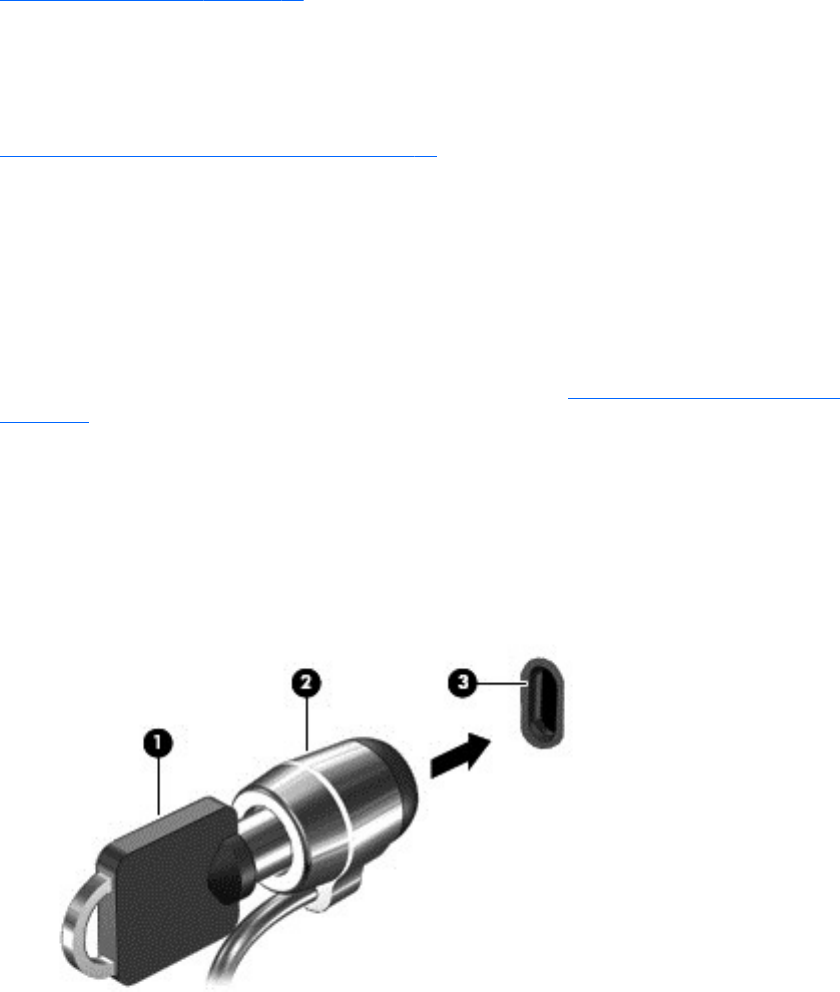
If you have installed third-party software after you purchased your computer, regularly update the
software. Software companies provide software updates to their products to correct security problems
and improve functionality of the software.
Securing your wireless network
When you set up your wireless network, always enable security features. For more information, see
Protecting your WLAN on page 17.
Backing up your software applications and information
Regularly back up your software applications and information to protect them from being permanently
lost or damaged through a virus attack or a software or hardware failure. For more information, see
Backing up, restoring, and recovering on page 56.
Using an optional security cable lock
A security cable lock, which is purchased separately, is designed to act as a deterrent, but it may not
prevent the computer from being mishandled or stolen. Security cable locks are only one of several
methods that should be employed as part of a complete security solution to help maximize theft
protection.
The security cable slot on your computer may look slightly different from the illustration in this section.
For the location of the security cable slot on your computer, see Getting to know your computer
on page 5.
1. Loop the security cable lock around a secured object.
2. Insert the key (1) into the security cable lock (2).
3. Insert the security cable lock into the security cable slot on the computer (3), and then lock the
security cable lock with the key.
4. Remove the key and keep it in a safe place.
52 Chapter 8 Securing your computer and information

9 Using Setup Utility (BIOS) and HP PC
Hardware Diagnostics (UEFI)
Setup Utility, or Basic Input/Output System (BIOS), controls communication between all the input and
output devices on the system (such as disk drives, display, keyboard, mouse, and printer). Setup
Utility (BIOS) includes settings for the types of devices installed, the startup sequence of the
computer, and the amount of system and extended memory.
Starting Setup Utility (BIOS)
To start Setup Utility (BIOS), turn on or restart the computer, quickly press esc, and then press f10.
NOTE: Use extreme care when making changes in Setup Utility (BIOS). Errors can prevent the
computer from operating properly.
Updating the BIOS
Updated versions of the BIOS may be available on the HP website.
Most BIOS updates on the HP website are packaged in compressed files called
SoftPaqs
.
Some download packages contain a file named Readme.txt, which contains information regarding
installing and troubleshooting the file.
Determining the BIOS version
To determine whether available BIOS updates contain later BIOS versions than those currently
installed on the computer, you need to know the version of the system BIOS currently installed.
BIOS version information (also known as
ROM date
and
System BIOS
) can be revealed by pressing
fn+esc (if you are already in Windows) or by using Setup Utility (BIOS).
1. Start Setup Utility (BIOS) (see Starting Setup Utility (BIOS) on page 53).
2. Use the arrow keys to select Main, and then make note of your current BIOS version.
3. To exit Setup Utility (BIOS) without saving your changes, use the arrow keys to select Exit,
select Exit Discarding Changes, and then press enter.
4. Select Yes.
Starting Setup Utility (BIOS) 53

Downloading a BIOS update
CAUTION: To reduce the risk of damage to the computer or an unsuccessful installation, download
and install a BIOS update only when the computer is connected to reliable external power using the
AC adapter. Do not download or install a BIOS update while the computer is running on battery
power, docked in an optional docking device, or connected to an optional power source. During the
download and installation, follow these instructions:
Do not disconnect power from the computer by unplugging the power cord from the AC outlet.
Do not shut down the computer or initiate Sleep.
Do not insert, remove, connect, or disconnect any device, cable, or cord.
1. From the Start screen, type hp support assistant, and then select the HP Support
Assistant app.
2. Click Updates and tune-ups, and then click Check for HP updates now.
3. Follow the on-screen instructions.
4. At the download area, follow these steps:
a. Identify the most recent BIOS update and compare it to the BIOS version currently installed
on your computer. If the update is more recent than your BIOS, make a note of the date,
name, or other identifier. You may need this information to locate the update later, after it
has been downloaded to your hard drive.
b. Follow the on-screen instructions to download your selection to the hard drive.
If the update is more recent than your BIOS, make a note of the path to the location on your
hard drive where the BIOS update is downloaded. You will need to access this path when
you are ready to install the update.
NOTE: If you connect your computer to a network, consult the network administrator before
installing any software updates, especially system BIOS updates.
BIOS installation procedures vary. Follow any instructions that are revealed on the screen after the
download is complete. If no instructions are revealed, follow these steps:
1. From the Start screen, type file, and then select File Explorer.
2. Click your hard drive designation. The hard drive designation is typically Local Disk (C:).
3. Using the hard drive path you recorded earlier, open the folder on your hard drive that contains
the update.
4. Double-click the file that has an .exe extension (for example,
filename
.exe).
The BIOS installation begins.
5. Complete the installation by following the on-screen instructions.
NOTE: After a message on the screen reports a successful installation, you can delete the
downloaded file from your hard drive.
Using HP PC Hardware Diagnostics (UEFI)
HP PC Hardware Diagnostics is a Unified Extensible Firmware Interface (UEFI) that allows you to run
diagnostic tests to determine whether the computer hardware is functioning properly. The tool runs
outside the operating system so that it can isolate hardware failures from issues that are caused by
the operating system or other software components.
54 Chapter 9 Using Setup Utility (BIOS) and HP PC Hardware Diagnostics (UEFI)

To start HP PC Hardware Diagnostics UEFI:
1. Turn on or restart the computer, quickly press esc, and then press f2.
The BIOS searches three places for the diagnostic tools, in the following order:
a. Connected USB drive
NOTE: To download the HP PC Hardware Diagnostics (UEFI) tool to a USB drive, see
Downloading HP PC Hardware Diagnostics (UEFI) to a USB device on page 55.
b. Hard drive
c. BIOS
2. When the diagnostic tool opens, use the keyboard arrow keys to select the type of diagnostic
test you want to run, and then follow the on-screen instructions.
NOTE: If you need to stop a diagnostic test, press esc.
Downloading HP PC Hardware Diagnostics (UEFI) to a USB device
NOTE: Instructions for downloading HP PC Hardware Diagnostics (UEFI) are provided in English
only.
1. Go to http://www.hp.com.
2. Point to Support, located at the top of the page, and then click the Download Drivers.
3. In the text box, enter the product name, and then click Go.
or
Click Find Now to let HP automatically detect your product.
4. Select your computer model, and then select your operating system.
5. In the Diagnostic section, click HP UEFI Support Environment.
or
Click Download, and then select Run.
Using HP PC Hardware Diagnostics (UEFI) 55

10 Backing up, restoring, and recovering
This chapter provides information about the following processes:
●Creating recovery media and backups
●Restoring and recovering your system
Creating recovery media and backups
1. After you successfully set up the computer, create HP Recovery media. This step creates a
backup of the HP Recovery partition on the computer. The backup can be used to reinstall the
original operating system in cases where the hard drive is corrupted or has been replaced.
HP Recovery media you create will provide the following recovery options:
●System RecoveryReinstalls the original operating system and the programs that were
installed at the factory.
●Minimized Image RecoveryReinstalls the operating system and all hardware-related
drivers and software, but not other software applications.
●Factory ResetRestores the computer to its original factory state by deleting all
information from the hard drive and re-creating the partitions. Then it reinstalls the
operating system and the software that was installed at the factory.
See Creating HP Recovery media on page 56.
2. Use the Windows tools to create system restore points and create backups of personal
information. For more information and steps, see Help and Support. From the Start screen, type
help, and then select Help and Support.
Creating HP Recovery media
HP Recovery Manager is a software program that offers a way to create recovery media after you
successfully set up the computer. HP Recovery media can be used to perform system recovery if the
hard drive becomes corrupted. System recovery reinstalls the original operating system and the
software programs installed at the factory, and then configures the settings for the programs. HP
Recovery media can also be used to customize the system or restore the factory image if you replace
the hard drive.
●Only one set of HP Recovery media can be created. Handle these recovery tools carefully, and
keep them in a safe place.
●HP Recovery Manager examines the computer and determines the required storage capacity for
the blank USB flash drive or the number of blank DVD discs that will be required.
●To create recovery discs, your computer must have an optical drive with DVD writer capability,
and you must use only high-quality blank DVD-R, DVD+R, DVD-R DL, or DVD+R DL discs. Do
not use rewritable discs such as CD±RW, DVD±RW, double-layer DVD±RW, or BD-RE
(rewritable Blu-ray) discs; they are not compatible with HP Recovery Manager software. Or
instead you can use a high-quality blank USB flash drive.
●If your computer does not include an integrated optical drive with DVD writer capability, but you
would like to create DVD recovery media, you can use an external optical drive (purchased
56 Chapter 10 Backing up, restoring, and recovering

separately) to create recovery discs, or you can obtain recovery discs for your computer from
support. See the
Worldwide Telephone Numbers
booklet included with the computer. You can
also find contact information from the HP website. Go to http://www.hp.com/support, select your
country or region, and follow the on-screen instructions. If you use an external optical drive, it
must be connected directly to a USB port on the computer; the drive cannot be connected to a
USB port on an external device, such as a USB hub.
●Be sure that the computer is connected to AC power before you begin creating the recovery
media.
●The creation process can take up to an hour or more. Do not interrupt the creation process.
●If necessary, you can exit the program before you have finished creating all of the recovery
DVDs. HP Recovery Manager will finish burning the current DVD. The next time you start HP
Recovery Manager, you will be prompted to continue, and the remaining discs will be burned.
To create HP Recovery media:
1. From the Start screen, type recovery, and then select HP Recovery Manager.
2. Select Recovery Media Creation, and then follow the on-screen instructions.
If you ever need to recover the system, see Recovering using HP Recovery Manager on page 58.
Restore and recovery
There are several options for recovering your system. Choose the method that best matches your
situation and level of expertise:
●Windows offers several options for restoring from backup, refreshing the computer, and resetting
the computer to its original state. For more information and steps, see Help and Support. From
the Start screen, type help, and then select Help and Support.
●If you need to correct a problem with a preinstalled application or driver, use the Drivers and
Applications Reinstall option of HP Recovery Manager to reinstall the individual application or
driver.
From the Start screen, type recovery, select HP Recovery Manager, select Drivers and
Applications Reinstall, and then follow the on-screen instructions.
●If you want to reset your computer using a minimized image, you can choose the HP Minimized
Image Recovery option from the HP Recovery partition (select models only) or HP Recovery
media. Minimized Image Recovery installs only drivers and hardware-enabling applications.
Other applications included in the image continue to be available for installation through the
Drivers and Applications Reinstall option in HP Recovery Manager.
For more information, see Recovering using HP Recovery Manager on page 58.
●If you want to recover the computer's original factory partitioning and content, you can choose
the System Recovery option from the HP Recovery partition (select models only) or use the HP
Recovery media that you have created. For more information, see Recovering using HP
Recovery Manager on page 58. If you have not already created recovery media, see Creating
HP Recovery media on page 56.
●If you have replaced the hard drive, you can use the Factory Reset option of HP Recovery
media to restore the factory image to the replacement drive. For more information, see
Recovering using HP Recovery Manager on page 58.
●If you wish to remove the recovery partition to reclaim hard drive space, HP Recovery Manager
offers the Remove Recovery Partition option.
Restore and recovery 57

For more information, see Removing the HP Recovery partition on page 59.
Recovering using HP Recovery Manager
HP Recovery Manager software allows you to recover the computer to its original factory state by
using the HP Recovery media that you created or by using the HP Recovery partition (select models
only). If you have not already created recovery media, see Creating HP Recovery media on page 56.
Using HP Recovery media, you can choose from one of the following recovery options:
●System RecoveryReinstalls the original operating system, and then configures the settings for
the programs that were installed at the factory.
●Minimized Image Recovery (select models only)Reinstalls the operating system and all
hardware-related drivers and software, but not other software applications.
●Factory ResetRestores the computer to its original factory state by deleting all information
from the hard drive and re-creating the partitions. Then it reinstalls the operating system and the
software that was installed at the factory.
The HP Recovery partition (select models only) allows System Recovery and Minimized Image
Recovery.
What you need to know
●HP Recovery Manager recovers only software that was installed at the factory. For software not
provided with this computer, you must either download the software from the manufacturer's
website or reinstall the software from the media provided by the manufacturer.
●Recovery through HP Recovery Manager should be used as a final attempt to correct computer
issues.
●HP Recovery media must be used if the computer hard drive fails. If you have not already
created recovery media, see Creating HP Recovery media on page 56.
●To use the Factory Reset option, you must use HP Recovery media. If you have not already
created recovery media, see Creating HP Recovery media on page 56.
●If the HP Recovery media does not work, you can obtain recovery media for your system from
support. See the
Worldwide Telephone Numbers
booklet included with the computer. You can
also find contact information from the HP website. Go to http://www.hp.com/support, select your
country or region, and follow the on-screen instructions.
IMPORTANT: HP Recovery Manager does not automatically provide backups of your personal
data. Before beginning recovery, back up any personal data you wish to retain.
Using the HP Recovery partition (select models only)
The HP Recovery partition (select models only) allows you to perform a system recovery or
minimized image recovery without the need for recovery discs or a recovery USB flash drive. This
type of recovery can only be used if the hard drive is still working.
To start HP Recovery Manager from the HP Recovery partition:
1. Press f11 while the computer boots.
or
58 Chapter 10 Backing up, restoring, and recovering

Press and hold f11 as you press the power button.
2. Select Troubleshoot from the boot options menu.
3. Select Recovery Manager, and then follow the on-screen instructions.
Using HP Recovery media to recover
You can use HP Recovery media to recover the original system. This method can be used if your
system does not have an HP Recovery partition or if the hard drive is not working properly.
1. If possible, back up all personal files.
2. Insert the HP Recovery media that you created, and then restart the computer.
NOTE: If the computer does not automatically restart in HP Recovery Manager, change the
computer boot order. See Changing the computer boot order on page 59.
3. Follow the on-screen instructions.
Changing the computer boot order
If computer does not restart in HP Recovery Manager, you can change the computer boot order,
which is the order of devices listed in BIOS where the computer looks for startup information. You can
change the selection for an optical drive or a USB flash drive.
To change the boot order:
1. Insert the HP Recovery media you created.
2. Restart the computer, quickly press esc, and then press f9 for boot options.
3. Select the optical drive or USB flash drive you want to boot from.
4. Follow the on-screen instructions.
Removing the HP Recovery partition
HP Recovery Manager software allows you to remove the HP Recovery partition to free up hard drive
space.
IMPORTANT: After you remove the HP Recovery partition, you can no longer use the Windows
Refresh option or the Windows option to remove everything and reinstall Windows. In addition, you
will not be able to perform System Recovery or Minimized Image Recovery from the HP Recovery
partition. So before you remove the Recovery partition, create HP Recovery media; see Creating HP
Recovery media on page 56.
Follow these steps to remove the HP Recovery partition:
1. From the Start screen, type recovery, and then select HP Recovery Manager.
2. Select Remove Recovery Partition, and then follow the on-screen instructions.
Restore and recovery 59

11 Specifications
Input power
The power information in this section may be helpful if you plan to travel internationally with the
computer.
The computer operates on DC power, which can be supplied by an AC or a DC power source. The
AC power source must be rated at 100240 V, 5060 Hz. Although the computer can be powered
from a standalone DC power source, it should be powered only with an AC adapter or a DC power
source supplied and approved by HP for use with this computer.
The computer can operate on DC power within the following specifications. Operating voltage and
current varies by platform.
Input power Rating
Operating voltage and current 19.5 V dc @ 2.31 A 45 W
19.5 V dc @ 3.33 A 65W
DC plug of external HP power supply
NOTE: This product is designed for IT power systems in Norway with phase-to-phase voltage not
exceeding 240 V rms.
NOTE: The computer operating voltage and current can be found on the system regulatory label.
Operating environment
Factor Metric U.S.
Temperature
Operating 5°C to 35°C 41°F to 95°F
Nonoperating -20°C to 60°C -4°F to 140°F
Relative humidity (noncondensing)
Operating 10% to 90% 10% to 90%
Nonoperating 5% to 95% 5% to 95%
Maximum altitude (unpressurized)
Operating -15 m to 3,048 m -50 ft to 10,000 ft
Nonoperating -15 m to 12,192 m -50 ft to 40,000 ft
60 Chapter 11 Specifications

12 Electrostatic Discharge
Electrostatic discharge is the release of static electricity when two objects come into contactfor
example, the shock you receive when you walk across the carpet and touch a metal door knob.
A discharge of static electricity from fingers or other electrostatic conductors may damage electronic
components. To prevent damage to the computer, damage to a drive, or loss of information, observe
these precautions:
●If removal or installation instructions direct you to unplug the computer, first be sure that it is
properly grounded, and then remove the cover.
●Keep components in their electrostatic-safe containers until you are ready to install them.
●Avoid touching pins, leads, and circuitry. Handle electronic components as little as possible.
●Use nonmagnetic tools.
●Before handling components, discharge static electricity by touching an unpainted metal surface
of the component.
●If you remove a component, place it in an electrostatic-safe container.
61

Index
Symbols/Numerics
2-finger pinch zoom TouchPad
gesture 28
2-finger pinch zoom touchPad
gesture 33
A
AC adapter 6
AC adapter, testing 42
action keys
decrease screen brightness
36
Help and Support 36
identifying 13
increase screen brightness 36
play, pause, resume 36
previous track or section 36
switch screen image 36
volume down 36
volume mute 36
volume up 36
wireless 36
antivirus software, using 51
audio features, testing 23
audio-out (headphone)/audio-in
(microphone) jack 8, 22
B
backing up software and
information 52
backups 56
battery
discharging 40
low battery levels 41
battery information, finding 40
battery power 40
Beats Audio 23
Beats Audio Control Panel 23
Beats Audio hot key 23
BIOS
determining version 53
downloading an update 54
updating 53
Bluetooth device 15, 20
Bluetooth label 14
boot order, changing 59
bottom 14
buttons
left TouchPad 11
power 7
right TouchPad 11
C
caps lock light, identifying 12
caring for your computer 46
cleaning your computer 46
components
display 9
left side 7
right side 6
top 11
connecting to a WLAN 18
connector, power 6
corporate WLAN connection 18
critical battery level 41
critical security updates,
installing 51
D
deleted files
restoring 57
Disk Cleanup software 46
Disk Defragmenter software 45
E
edge-swipe gestures 29, 34
bottom-edge swipe 35
top-edge swipe 35
electrostatic discharge 61
esc key, identifying 13
external AC power, using 41
F
firewall software 51
fn key, identifying 13, 37
fun things to do 1
H
hard drive
HP 3D DriveGuard 45
hard drive light 6
HDMI
configuring audio 25
HDMI port
connecting 24
identifying 6, 21
headphones and microphones,
connecting 23
Hibernation
exiting 39
initiated during critical battery
level 41
initiating 39
high-definition devices,
connecting 24, 25
hot keys
description 37
using 37
HP 3D DriveGuard 45
HP and third-party software
updates, installing 51
HP Mobile Broadband, disabled
19
HP PC Hardware Diagnostics
(UEFI)
downloading 55
using 54
HP Recovery Manager
correcting boot problems 59
starting 58
HP Recovery media
creating 56
recovery 59
HP Recovery partition
recovery 58
removing 59
I
input power 60
installing
critical security updates 51
optional security cable lock 52
internal display switch,
identifying 9
62 Index
internal microphone, identifying
9, 21
Internet connection setup 17
Internet security software, using
50
J
jacks
audio-out (headphone)/audio-in
(microphone) 8, 22
network 6
RJ-45 (network) 6
K
keyboard hot keys, identifying 37
keys
action 13
esc 13
fn 13
Windows 13
L
labels
Bluetooth 14
regulatory 14
serial number 13
service 13
wireless certification 14
WLAN 14
LAN, connecting 20
left-edge swipe 30, 34
lights
AC adapter 6
caps lock 12
hard drive 6
mute 12
power 7
RJ-45 (network) status 6
low battery level 41
M
maintenance
Disk Cleanup 46
Disk Defragmenter 45
memory card
inserting 6
removing 6
memory card reader, identifying
6, 22
minimized image recovery 58
minimized image, creating 58
Miracast 25
mouse, external
setting preferences 26
mute light, identifying 12
N
network jack, identifying 6
O
operating environment 60
original system recovery 58
P
passwords
Setup Utility (BIOS) 50
Windows 50
ports
HDMI 6, 21, 24
Miracast 25
USB 2.0 6, 7, 22
USB 3.0 6, 22
power
battery 40
power button, identifying 7
power connector, identifying 6
power lights, identifying 7
product name and number,
computer 13
public WLAN connection 18
R
recovery
discs 56, 59
HP Recovery Manager 58
media 59
options 57
starting 58
supported discs 56
system 58
USB flash drive 59
using HP Recovery media 57
recovery media
creating 56
creating using HP Recovery
Manager 57
recovery partition
removing 59
regulatory information
regulatory label 14
wireless certification labels 14
restore
Windows File History 57
right-edge swipe 29, 34
RJ-45 (network) jack, identifying
6
RJ-45 (network) status lights,
identifying 6
S
scrolling TouchPad gesture 28
security cable lock, installing 52
security cable slot, identifying 7
security, wireless 17
serial number 13
serial number, computer 13
service labels, locating 13
setting password protection on
wakeup 39
setup of WLAN 17
Setup Utility (BIOS) passwords
50
shipping the computer 47
shutdown 43
SIM
inserting 19
removing 19
SIM slot, identifying 6, 22
Sleep
exiting 39
initiating 39
slots
memory card reader 6, 22
security cable 7
SIM 6, 22
software
Disk Cleanup 46
Disk Defragmenter 45
software updates, installing 51
speakers
connecting 23
identifying 12, 22
supported discs, recovery 56
system recovery 58
system restore point
creating 56
T
tapping TouchPad gesture 27
testing an AC adapter 42
testing audio features 23
Index 63
top-edge swipe 30
touch screen gestures 34
2-finger pinch zoom 33
bottom-edge swipe 35
edge-swipe gestures 34, 35
one-finger slide 31
scrolling 32
tapping 32
top-edge swipe 35
touch screen, using 31
TouchPad
buttons 11
TouchPad gestures
2-finger pinch zoom 28
scrolling 28
tapping 27
TouchPad zone, identifying 11
traveling with the computer 14,
47
turning off the computer 43
U
unresponsive system 43
USB 2.0 ports, identifying 6, 7,
22
USB 3.0 ports, identifying 6, 22
using external AC power 41
using passwords 49
V
vents, identifying 7
video 24
volume button 8
W
webcam
identifying 9, 21
using 22
webcam light, identifying 9, 21
Windows
File History 57
restoring files 57
system restore point 56
Windows key, identifying 13
Windows passwords 50
Wireless Assistant software 15
wireless button 15
wireless certification label 14
wireless controls
button 15
operating system 15
Wireless Assistant software
15
wireless network (WLAN)
connecting 18
corporate WLAN connection
18
equipment needed 17
functional range 18
public WLAN connection 18
security 17
using 16
wireless network, securing 52
WLAN antenna, identifying 9
WLAN device 14, 16
WLAN label 14
WWAN antennas, identifying 9
WWAN device 18
64 Index